News about weavers
|
2011-07-04
Weaver breeding information 
You can now find the latest breeding information for every weaver species on PHOWN (Photos of Weaver Nests). This means that you can: (i) look up published info here, and (ii) compare the published info with that in PHOWN, especially data on colony sizes and breeding seasonality. There is already improved data in PHOWN on colony sizes in some weavers. For Southern Brown-throated Weaver, for instance, the Handbook of the Birds of the World, Vol. 15 (HBW) gives the following: "Colonial, with up to 300 nests together" and data currently in PHOWN gives colony size as 2-15 nests, mean 9.3 (n=3). Similarly, for the Lesser Masked Weaver, HBW says: "Colonial, up to 60 nests at a site", while PHOWN provides much improved information: 5-65 nests, mean 22.3, for 6 colonies. Again, for Yellow Weaver, HBW gives "Colonial; in reedbeds seldom more than 50 nests together, but 150 nests in tamarind tree (Tamarindus) on Zanzibar" while PHOWN provides the following information: 3-64 nests, mean 27.3, for 18 colonies. No species has enough data yet - more records are needed for all species to study variation in colony size geographically and in different years. Records from long ago can be submitted if you have a photo, GPS location, and date (nest count and other data is preferable but if you don't have this, still submit the record). To browse records and find out about submitting records, read here. |
|
2011-06-27
Weaver chick now 1 year 10 months 12 days old 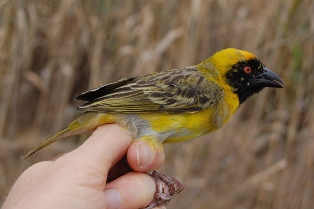
On 25 June Southern Masked Weaver BD13864 was recaptured at Frogmore, Cape Town, in some reeds just north of Zandvlei. Although it is mid winter, this bird was virtually in full breeding plumage with a few yellow feathers left to moult on the mask. The recapture was special as it had been ringed as a chick on 13/08/2009 at Westlake, less than 1 km from the recapture site. It was in a nest in reeds and the nest had two chicks which were both well feathered. Chicks were ringed in 2007 for a study on natal dispersal in weavers. Male Southern Masked Weavers start breeding at age 2 years (females can start at age 1 year). No nests were found near the ringing site, indicating that BD13864 has not started his first colony yet, but may do so soon. The first few weaver nests are being built at some sites in Cape Town - see PHOWN (Photos of Weaver Nests). |
|
2011-06-24
Africa's feather locust is both an adder and a mulitplier 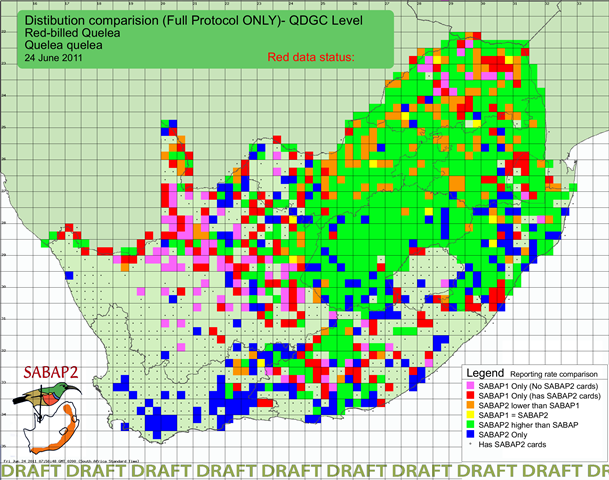
Africa's feathered locust is the Red-billed Quelea. Compared with SABAP1, it is adding range, and it is apparently multiplying in numbers. All the BLUE quarter degree grid cells represent places where it was not recorded in SABAP1, but has been recorded in SABAP2. The range expansion westwards, especially into the winter-rainfall region of the Western Cape is striking. The overall impression of the map is GREEN, indicating that reporting rates for the Red-billed Quelea are higher in SABAP2 than they were in SABAP1 (and in many grid cells throughout the range the reporting rates are substantially higher now). The closest quelea breeding colony to Cape Town was found near Worcester in April 2009 - see here. Recent records in the winter rainfall area can be found here. |
|
2011-06-20
MSc opportunity on Sociable Weavers 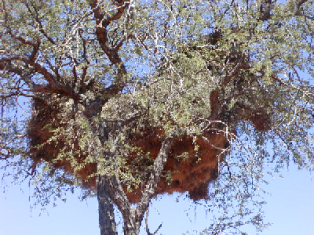
Study opportunity: MSc research at the Percy FitzPatrick Institute of African Ornithology (PFIAO), Department of Zoology, University of Cape Town
The successful applicant will have a BSc Honours or equivalent, relevant ornithological field experience and a demonstrated ability to work independently. The student should have a strong interest in pursuing theoretical questions in behavioural ecology and motivation for conducting demanding fieldwork. Experience in handling birds and behavioural observations are important advantages. To apply, please send a CV (including your academic record & names and contact details of three referees) and a short motivation for why you wish to undertake this research to Hilary Buchanan (hilary.buchanan [at] uct.ac.za). Closing date: 01 July 2011. |
|
2011-06-15
Oldest Thick-billed Weaver 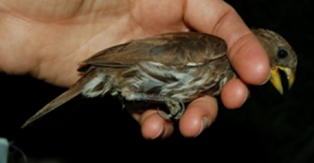
Thick-billed Weaver 4H16349 was ringed as an adult female by Mark Brown on 2001-03-19 at the University of KwaZulu-Natal, Pietermaritzburg. It has been recaptured at the same site seven times, the last time being on 2011-05-25, making it at least 10 years 2 months 6 days old.
Mark says: "these two birds were netted by Minke Witteveen and Dominoc Rollinson, two trainee ringers, 40m from my office where I can keep an eye on them! We put all the swept up seed from the UKZN Aviaries out for the birds and are visited mostly by Thickbilled Weavers, Laughing Doves, Redeyed Doves and Greyheaded Sparrows." To see the greatest elasped times for southern African weavers, see here. Photo: female Thick-billed Weaver |
|
2011-06-13
Most ringed weavers The top five species ringed over the last 62 years are Barn Swallow (n=168287), Red-billed Quelea (134577), Southern Masked Weaver (125246), Cape Gannet (106351), and Southern Red Bishop (105393). So three weavers are in the top 5 ringed birds. The peaks of quelea ringing correspond to government funding to study this pest species. SAFRINGs annual ringing reports are available online here, showing the ringing totals for all species. In the 1950s most of the total annual catch comprised of Red-billed Queleas. Initially the reports were published in Ostrich (until 1983), then in Safring news and Afring News (note that many of these reports are several MB in size).
|
|
2011-06-11
New weaver species for Egypt 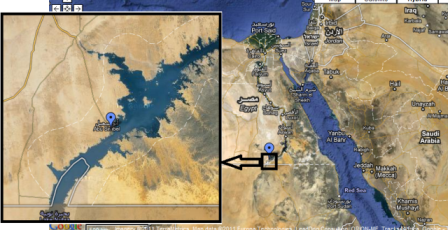
This month a record of a Village Weaver Ploceus cucullatus was accepted for Egypt. The bird was seen at Abu Simbel (near southern border of Egypt), Lake Nasser, on 2006-05-01, see here and choose 'June 2011'. The origin of the weaver is unknown and the closest normal distribution is over 900 km away in Sudan. One other weaver species occurs in Egypt: the Streaked Weaver Ploceus manyar (see full species list here). The Streaked Weaver was introduced to the Nile Delta in the 1970s and appears to be resident.
|
2011-06-06
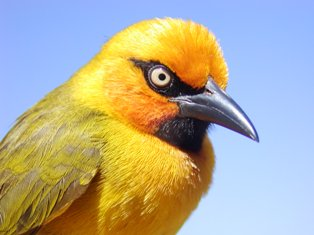
PAPER: Weaver eye colours HD Oschadleus. Iris colours in ageing and sexing South African Ploceus weavers. Afring News 40:7-12 Eye colours can be quite striking in some weavers. A calculation shows that globally in weavers the distribution of eye colour is 78% brown, 21% pale, and 10% red. Knowing the eye colours of all age and sex groups can prevent errors in ageing and sexing weavers in the hand by ringers. For the eight Ploceus species studied here, adult males have coloured eyes in summer and in winter, although they may be less bright in winter (more data is needed for Southern Brown-throated Weavers in winter). Adult females of Golden, Spectacled and Lesser Masked Weavers appear to have pale eyes in adults of both sexes year round. In the other species, varying proportions of the adult females have pale or red eyes in summer, and even less individuals have coloured eyes in winter. Juveniles have dark brown eyes in all species and in some species this colour lightens after several months in males. Using only eye colours is thus unreliable for ageing and sexing South African Ploceus weavers. Read the article here and other weaver identification papers here.
|
|
2011-05-30
Weaver birds may hold secret of ageing 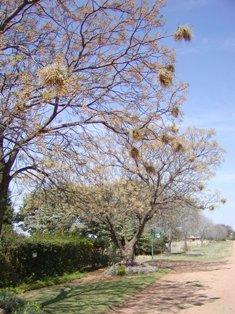
Dominic Cram, with supervisor Dr Andy Young at the University of Exeter, UK, are studying the cooperative behaviour of White-browed Sparrow-weavers at Tswalu in the Northern Cape, South Africa. The social life of these weavers in 30 colonies is helping biologists work out whether a life of leisure slows down the ageing process. Read the story in a series of 8 photos on the New Scientist web. 70 colonies of White-browed Sparrow-weavers have already been submitted to PHOWN, with colonies form the Eastern Cape right up to Ethiopia. Photo: White-browed Sparrow Weaver colony in Deneysville |
|
2011-05-23
Summaries of weaver ringing sessions 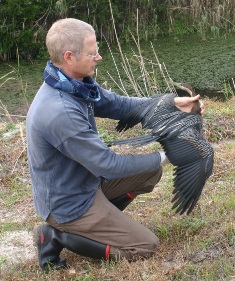
There is regular ringing in Cape Town to ring and recapture weavers and other birds, to study their moult, movements and other aspects of their biology. A web summary will be available for recent and future ringing sessions here (scroll to the bottom). Choose a ringing session and click on the web link. A new page will open showing the locality of the session and the total birds ringed and recaptured. Grey tabs above the map show other summaries, in particular, a species list and recapture details. At the most recent session at Frogmore, a total of 70 birds were caught, mostly Southern Masked Weavers (n=33) and, amazingly, a rare catch in a mistnet was an adult African Darter! (Photo: Sue Schultz). |
|
2011-05-16
Sasol birds and birding fair 2011 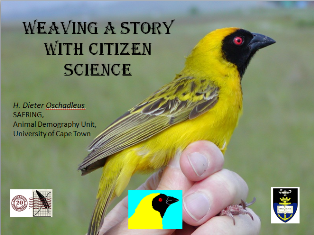
The Sasol birds and birding fair 2011 runs from 28-29 May at the Johannesburg Zoo. There will stalls, including a bird ringing stall (SAFRING), and talks including one on weaver bird demography entitled "Weaving a story with Citizen Science" (old title: "Weaver demography relating to several subjects: climate change, wetlands, citizen science and ringing"). |
2011-05-11
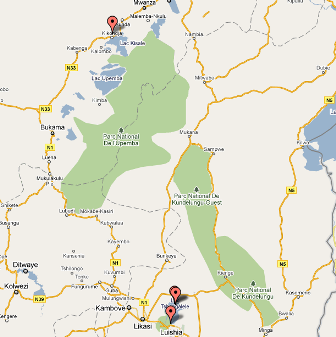
PAPER: Lufira Masked Weaver range Craig AJFK, Hasson M, Jordaens K, Breman F, Louette M. 2011. Range extension of the Lufira Masked Weaver Ploceus ruweti, endemic to Katanga province, Democratic Republic of Congo. Ostrich 82:77-78 The Lufira Masked Weaver Ploceus ruweti, known previously solely from the holotype collected at Lake Lufira (= Lake Tshangalele) in Katanga, south-eastern Democratic Republic of Congo (Congo-Kinshasa), in 1960, was rediscovered nesting at the same locality in February - March 2009. This discovery was reported in Bulletin of the African Bird Club - see here for a link to the paper. In a new paper, a range extension of 120 km is described for this species. All records are in the Lufira River valley and it is expected that the weaver occurs in the intervening area. Two females were captured, ringed (AP23405 and AP23406) and released. Also see Craig A, Hasson M, Louette M. 2010. Retracing old footsteps. Katanga's endemic weavers. Africa - Birds & Birding 15(6):42-47. Map: records of the Lufira Masked Weaver in the Democratic Republic of Congo; the southern records are around Lake Tshangalele (formerly Lake Lufira). |
|
2011-05-09
The least known breeding factor in weavers 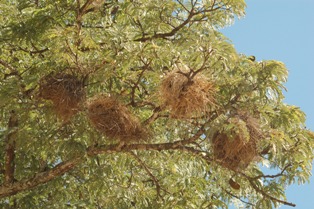
For most weavers the basic breeding factors are known, i.e. breeding season, clutch size, incubation and fledgling periods. One of the least known breeding factors, and yet one of the easiest to collect, is colony size. The reason for this is that colony sizes vary, particularly in polygnous species. Colony size is important as a determinant of breeding success; males with more nests attract more females and have a higher breeding success - there is evidence for this in at least Southern Red Bishops, Cape Weavers, Village Weavers and Southern Masked Weavers, and this probably holds true for most polygnous weavers. Citizen scientists can help provide data on colony sizes by photographing weaver nests and submitting the records to PHOWN (Photos of Weaver Nests). PHOWN already has data on colony sizes for 33 weaver species: see here, and some of this data is new. For instance, the Handbook of the Birds of the World, Vol. 15 (HBW) is the most recently published summary of weaver information and it does not have any data on colony sizes for the White-browed Sparrow-Weaver. Data currently in PHOWN gives colony size for this species as 1-35 nests, mean 12.8 (n=60). Similarly, for the Lesser Masked Weaver, HBW says: "Colonial, up to 60 nests at a site", while PHOWN provides much improved information: 5-65 nests, mean 22.3, for 6 colonies. No species has enough data - more is needed to study variation in colony size geographically and in different years. Many weavers are monogamous and solitary but records of these are still valuable for studying other aspects of weaver breeding biology. To find out more about submitting records, read here. Records from long ago can be submitted if you have a photo, gps location, and date (nest count and other data is preferred but optional). |
|
2011-05-03
Most southerly Sociable Weaver colony 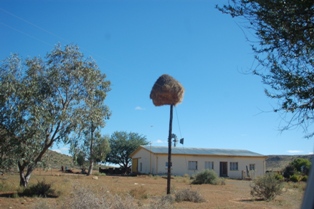
The most southerly Sociable Weaver colony known was recorded by Richard Brooke 21 years ago while atlasing for SABAP1. In a trip to the Williston area, Northern Cape, Barry and Sue Schultz and I found this very colony. It was no longer active but a Sociable Weaver nest mass was found a few hundred metres closer to the farm house. This nest mass was active, with adults feeding chicks. A few days later we returned and ringed 71 adults and 74 juveniles at this colony. Not all birds were caught, and the colony consisted of an estimated 200 birds. 60 nest chambers were counted (VM 748). Unfortunately several birds were dead, hanging from threads that they had built into the nest. This was found subsequently at other colonies as well - no ringing has taken place here previously (SAFRING database) and the birds were caught mostly on their toes. The Williston area was searched for other colonies, and farmers were interviewed. Colonies on sheds were found, but none further south. Read more here. |
|
2011-04-18
PAPER: Chestnut Weaver records 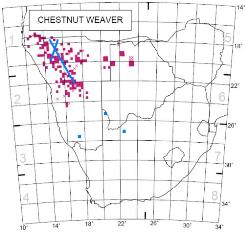
Whittington M, 2011. Chestnut Weaver Ploceus rubiginosus, a brand new visitor to South Africa. Ornithological Observations 2:32-33 Oschadleus HD, 2011. Chestnut Weaver movements in southern Africa. Afring News 40:1-3 Two papers on Chestnut Weavers have been published. The first paper describes the first record of the species in South Africa, as reported in January 2011 - see here. The second paper describes long distance movements in the species, based on ringing records and out-of-range sightings. The longest distance recorded anywhere in Africa is at least 580 km, for a bird ringed at Okapuka, Namibia, by Dirk Heinrich and recovered in northern Namibia. Click on the above links to read the full papers. |
|
2011-04-12
Ethiopia dials in to PHOWN 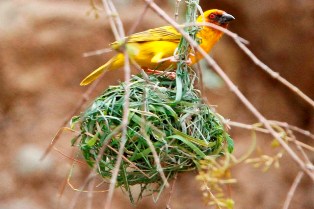
The first records from Ethiopia have been added to PHOWN. The 33 records were submitted by Arnia Van Vuuren, S Swarts and Abiye Dagne. Arnia has already submitted over 100 PHOWN records, mostly from South Africa. Several species are included in PHOWN for the first time: White-headed Buffalo Weaver (3 records), Chestnut-crowned Sparrow-Weaver (1), Ruppell's Weaver (4), Speke's Weaver (1), Grey-capped Social Weaver (1) and Black-capped Social Weaver (2). In addition, there are records of Red-billed Buffalo-Weaver (1), White-browed Sparrow-Weaver (17), Red-headed Weaver (2) and Village Weaver (1). To see the Ethiopian PHOWN records, see here. Photo: A Van Vuuren, from VM 696 |
|
2011-04-11
PAPER: Nelspruit bird changes McKenzie D, 2011. Reporting rate comparisons for birds in the Nelspruit area – SABAP1 vs SABAP2. Ornithological Observations 2:22-31 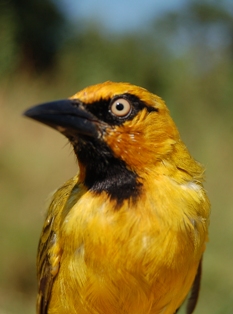
The author compares reporting rates of birds from the first (1987-91) and second (2007-) Southern African Bird Atlas Projects (SABAP1 & 2) for the Nelspruit quarter degree grid cell (2530BD) in Mpumalanga. At the time of writing 215 cards had been submitted for this grid cell for both projects. Of the 15 Ploceidae species, all but three show an increase in reporting rate, often a dramatic increase. The exceptions are: Yellow-crowned and Yellow Bishops have not been recorded during SABAP2, and the Red-headed Weaver has a lower reporting rate in SABAP2. The author notes that generally wetland and grassland species show significantly lower reporting rates now, and forest and woodland birds are reflecting large increases in reporting rates in SABAP2. While many of the weavers use wetlands, they are adaptable and can cope with rivers that are overgrown with weeds and exotics, as well as using wooded areas and gardens. To read the paper, click on the journal reference above. The weaver with the highest reporting rate is Spectacled Weaver (93%, SABAP2), placing it ninth of the most common birds in Nelspruit, where the Dark-capped Bulbul is first (99%). Nine of the Nelspruit weaver species were ringed in a recent visit - see here.
|
|
2011-04-04
Thick-billed Weaver range expansion The Thick-billed Weaver arrived in Gauteng in the early 1960s from Mpumalanga, and slowly increased in numbers. Johannesburg and Pretoria have many parks and wetlands with reed beds which provide ideal nesting sites for this species. In the non-breeding season it feeds on seeds, fruits and insects. In the original range, these were mainly obtained in forests, but the gardens of Gauteng provide a suitable alternative habitat with adequate food. The SABAP2 range-change map shows that in recent years the population has increased dramatically in Johannesburg and Pretoria and that this species is expanding its range beyond Gauteng. The range change observed for this species seems to be mostly accounted for by changes to the habitat (rather than to climate change). There are several PHOWN records for this species, including records in Gauteng.
|
|
2011-03-31
Weaver type collected today
Today some 117 weaver bird species are recognised. However, over 600 weaver taxa have been described, either as full species or as sub-species. Many of these taxa have been found to not be valid but having been described, they provide published records of specimens. These records may provide important historical records of species occurence. A new feature on the Weaver Watch webpages is giving a weaver type on the day that it was collected. The date of this news item is 31 March, and on this day (in 1908) a weaver was collected that was later described as a new species: Ploceus graueri. This is no longer considered a separate species but it is a Village Weaver. This particular taxon was collected by Mr Rudolf Grauer at Usumbura, on the north end of Lake Tanganyika, as a series of several individuals. It was described 3 years later by Ernst Hartert, curator of Tring in England. Ernst named it after the collector. A box on the weaver Watch home page will be updated daily, showing a weaver type that was collected on that day - the box will show the date of collection, the original name and the current species that the taxon belongs to. 247 days of the year are covered, ie. on 118 days no weaver types are known to have been collected. |
|
2011-03-24
PAPER: Southern Red Bishop testosterone Edler R, Goymann W, Schwabl I, Friedl TWP, 2011. Experimentally elevated testosterone levels enhance courtship behaviour and territoriality but depress acquired immune response in Red Bishops Euplectes orix. Ibis 153: 46-58 
Abstract.The immunocompetence handicap hypothesis (ICHH) posits that the hormone testosterone mediates a trade-off between investment in reproduction and immunological condition. In this study, we tested the ICHH in the Red Bishop Euplectes orix, a polygynous weaverbird. Males of this strongly sexually dimorphic species show an elaborate courtship display to attract females and compete aggressively with other males for nesting sites in breeding colonies. We experimentally elevated testosterone levels in breeding male Red Bishops kept in an aviary with a subcutaneous implantation of testosterone-releasing pellets. We then compared behaviour, development of territory size and immunological condition (as assessed through a white blood cell count) of the experimental group with a control group treated with placebos. In addition, we measured the primary and secondary response to phytohaemagglutinin (PHA) to investigate the effect of testosterone on both innate and acquired immunity. Males with elevated levels of testosterone enlarged their territories and conducted more courtship behaviour, while showing a decrease in health, expressed by an increased heterophil / lymphocyte ratio compared with the control group. Males of the control group showed an increase of the secondary response to PHA, as expected under the assumption that repeated exposure to an antigen enhanced the immune response due to acquired immunity. However, males with experimentally increased testosterone levels did not show such an enhanced immune response in the secondary PHA test (although sample size and power of the statistical tests were low), indicating that testosterone treatment might directly or indirectly suppress some component of the acquired immune response. |
|
2011-03-22
Weavers at Barberspan and Nelspruit
An atlasing and ringing workshop was held at Barberspan from 9-16 March 2011. Nearly 700 birds were ringed by a small team of ringers and trainees. Many new pentads were atlased and many Virtual Museum records added. Photos and more details about the workshop may be viewed here. After the core part of the course, I left for Nelspruit to target tropical weaver species and then attend the BLSA annual meeting. Nearly 300 birds were ringed, mostly weavers - read more here. Combining data from intensive ringing, atlasing, and the Virtual Museum records may prove useful in studying populations of birds, especially if visits are repeated to the same area. The data from these trips await analysis! |
|
2011-03-03
Sparrow-weavers at Barberspan
In March 2010 there were 51 nests in three colonies - two colonies may be viewed in PHOWN and the third colony was in the campsite and had 5 nests. This suggests an increase in the population but doesn't show how the population changed over time. SAFRINGs ringing records were extracted (red line in Fig. at right) but ringing at the office and camp area was too sporadic to draw firm conclusions. In recent years retraps (green line in Fig.) have been submitted more frequently and this could allow survival to be estimated. There is an atlasing and ringing workshop at Barberspan from 9-16 March 2011, and there will be ringing and PHOWNing to compare the current population with last year. |
|
2011-03-01
Exciting PHOWN records
Two species have PHOWN records as well as Nest Record Cards that have been digitised, see Chestnut Weaver and Southern Brown-throated Weaver. Click on a thumb-nail to see details of an individual record. You can choose any species to see the records available. Thanks to all participants for your records! Photo: Sally Adam, boomslang with Cape Weaver chick |
|
2011-02-23
PAPER: Gabar Goshawk attack on weavers Gjerstad D, 2010. Gabar Goshawk attack. Gabar 21:68 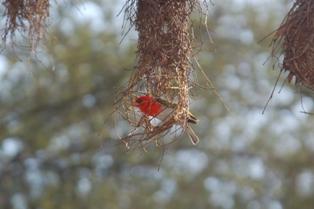
The author observed two Gabar Goshawks attacking Red-headed Weaver nests in Maun, Botswana. The goshawks were driven away by Red-billed Buffalo weavers (also nesting here) and some rollers. The story previously appeared here. For PHOWN (Photos of Weaver Nests) records of Red-headed Weaver see here. (Photo: HD Oschadleus, KNP) |
|
2011-02-23
PAPER: Eagle predation on quelea colony Bernitz Z, 2010. Feeding behaviour of Lesser Spotted Eagle Aquila pomarina at a quelea Quelea quelea colony in the Kruger National Park. Gabar 21:60-63 The author observed a Red-billed Quelea colony in Capricorn Enclosure in the northern part of Kruger National Park, from 11-15 January 2010. The quelea nests were concentrated in small Location of colony in google maps (green arrow)
|
|
2011-02-22
PAPER: Range changes Hockey PAR, Sirami C, Ridley AR, Midgley GF, Babiker HA, 2011. Interrogating recent range changes in South African birds: confounding signals from land use and climate change present a challenge for attribution. Diversity and Distribution 17:254-261 Abstract. Aim Apparent anthropogenic warming has been underway in South Africa for several decades, a period over which significant range shifts have been observed in some indigenous bird species. We asked whether these range shifts by birds are clearly consistent with either climate change or land use change being the primary driver.
|
|
2011-02-17
Village Weaver northern race
This record adds to the growing number of sightings of Ploceus cucullatus nigriceps. For more records with photos, see Raijmakers 2010 and Brooks 2010. To read more about the two races see here. Photo: Village Weavers, northern race in front, SA race behind (S. McCartney) |
|
2011-02-16
English names of weavers Ploceus subaureus Smith 1839 and P. xanthops Hartlaub 1862 have had confusing English names, especially since Golden Weaver in southern Africa generally refers to P. xanthops and in eastern Africa it refers P. subaureus. There have been many variations of the names of both species. The current International Ornithological Congress names are Eastern Golden Weaver and Holub's Golden Weaver respectively, and the SA list committee is deciding if it should follow this or not. Are there guidelines that could be used to decide on the names for these two weavers?
There is no simple way to decide on universal names for these species that will satisfy every one.
|
|
2011-02-07
Chestnut Weaver breeding records
There are 38 Nest Record Cards at the ADU for this species, and these have been converted into a format for PHOWN by Heidemarie Swanepoel. These records include the colony details and in place of photos there are images of the actual cards. The coordinates are approximate as they were not provided on the original cards. The cards, and normal Virtual Museum records, may be viewed here. Click on an image to see the details for that record, or scroll down to see a map for all the Chestnut Weaver breeding records. |
|
2011-02-01
PAPER: Sociable Weaver helpers Covas R, Deville A-S, Doutrelant C, Spottiswoode CN, Gregoire A. 2011. The effect of helpers on the post-fledging period in a cooperatively breeding bird, the social weaver. Animal Behaviour 81:121-126 Abstract. Understanding the evolution of cooperation requires determining the costs and benefits of cooperative behaviour. In cooperative breeders, where nonbreeding individuals assist in raising offspring, these 'helpers' are expected to increase the fitness of breeders and hence empirical research has focused on the effect they have on reproductive output and breeder survival. However, the effects of helpers during the postfledging period are poorly known because of the difficulty of tracking fledglings in the wild. Helper presence might be beneficial for fledglings, for example through continuous food delivery or increased predator vigilance, but potential competition between helpers and fledglings, or changes in investment of parents assisted by helpers, could counteract these positive effects and have a negative influence on postfledging survival probabilities or promote dispersal. We investigated the survival of juvenile sociable weavers, Philetairus socius, raised in pairs alone versus pairs with helpers by using capture-mark-recapture methods to control for individual detectability in survival estimation. We found that local survival in the first year was reduced in young raised by groups versus those raised by pairs. This may reflect either higher mortality or emigration of juveniles raised in groups. Hence, our study reveals significant postfledging effects of cooperative breeding that have not been reported previously and that need to be investigated in studies addressing the evolution of cooperative breeding.
|
|
2011-01-31
Second PHOWN newsletter
There are now records from all South African provinces. In addition to South Africa, there are submissions from Angola, Madagascar, Namibia, Rwanda and Zimbabwe. Submissions from all countries where weavers breed are welcome. Some interesting records are highlighted in the newsletter. Read it here. |
|
2011-01-28
Weaver records on the Vaal Dam
|
|
2011-01-17
Chestnut Weavers - first records for SA 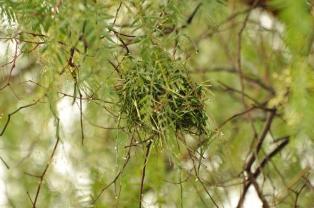
The southern race of the Chestnut Weaver occurs in Namibia, Botswana and Angola. Madel Whittington reported the first record of this species in Nossob in the Kgalagadi Transfrontier Park, and the record was posted to Sabirdnet on 11 January 2011. Bird ringer Ben Smit saw a male on 14 January 2011 and reports as follows: "This morning I was very surprised to find a male Chestnut Weaver in full breeding plumage building a nest in amongst a Southern Masked Weaver colony in a garden in Tswalu Kalahari Reserve, Northern Cape - well within the SA boundaries! The bird is currently having a hard time trying to get female mask weavers interested and fending off attacks by the Masked males!" A team of atlasers drove to Tswalu on the weekend and Tony Archer took a photo of this nest on 16 January to submit to PHOWN - see here. In Namibia the Chestnut Weaver is resident in parts and nomadic in other parts. The longest distances published for the species are of a bird ringed at Ngulia in Kenya and caught 213 km away 5 months later, and a bird in Namibia that moved 284 km. The closest known site for Chestnut Weavers to Nossob is 283 km (SABAP1 distribution) and from Tswalu it is 557 km. |
|
2010-12-31
BOOK: Birds of the World, 15 Craig AJFK, 2010. Family Ploceidae (Weavers). Pp. 74-197 in: del Hoyo J, Elliott A, Christie DA (eds). Handbook of the Birds of the World. Vol. 15. Weavers to New World Warblers. Lynx Edicions, Barcelona 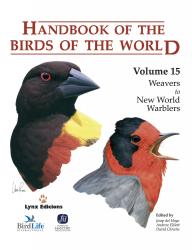
Vol 15 of this series starts with the weaver family Ploceidae and contains 116 weaver species. The taxonomy differs in some respects to "The Birds of Africa Vol 7" (Fry CH, Keith S. 2004. Helm, London), for instance Quelea and Euplectes are placed at the start of the Ploceinae (after the Thick-billed Weaver) rather than at the end.
Plates
Reviews:
|
|
2010-12-20
Narrative of a name: red-headed or black-eared? 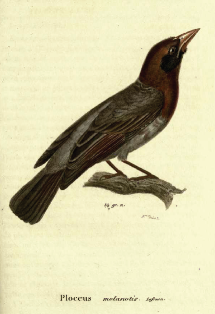
The Red-headed Weaver was first described in 1839 by a French collector, Lafresnaye. He used the name Ploceus melanotis which was pre-occupied (already used) and thus is invalid, even though this particular name is no longer in use. The first valid scientific name to be used was by Sundevall who described several specimens collected by the Swedish big game hunter, Johan August Wahlberg, in November 1843 at Mohapoani (North West Province). All modern world checklists and the recent Handbook of Birds of the World Vol 15 use the correct name Anaplectes rubriceps. The name P. melanotis used in Roberts 7, and subsequent bird books using the species list in Roberts 7, is incorrect and authors of southern African bird books need to use the name Anaplectes rubriceps. Read the full story here. Left: The first published illustration of a Red-headed Weaver, by Lafresnaye (1839). |
|
2010-12-17
PAPER: Marooned Mauritius Fodies Cristinacce A, Garrett LJH, Cole RE, Vikash Tatayah RV, Jones CG. 2010. Nesting success of a managed population of Mauritius Fodies Foudia rubra marooned on a partially restored island. Bird Conservation International 20:365-374 Abstract. The marooning of populations on offshore islands can be used as a conservation technique for species threatened by introduced predators, but post-release breeding success is not always as high as expected. Following the release of Mauritius Fodies onto a partially restored islet of regenerating forest, supplementary food and control of nest parasites through the application of insecticide were used as precautionary measures to aid the establishment of a population. Nests were continuously monitored in the first three breeding seasons to inform future management decisions. The fodies built nests in taller, more mature vegetation and younger females were more likely to abandon nests before incubation started. Eggs were laid between July and February and nests made earlier in the season were more likely to fledge young. Treating nests with the insecticide carbaryl increased the probability of success, but the distance of the nest from the supplementary feeding aviaries had no effect. The number of young per female decreased each breeding season and nesting success was similar to that of fodies using exotic plantation trees on the mainland between 2002 and 2006. Future research using population models and adaptive management could lead to the withdrawal or reduction of support measures for the released population and/or the harvest of individuals to establish populations on other offshore islands. This paper describes how a population of Mauritius Fodies were established on Ile aux Aigrettes (left map: red marker, right map: enlarged) in Mauritius.
|
|
2010-11-26
Success in coastal Zululand! 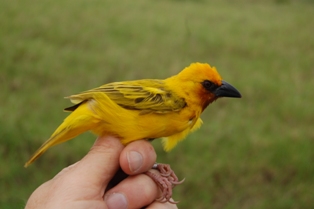
A team of ringers visited Futululu, Bonamanzi, Twinstreams and Sappi Stanger to ring birds along Zululand's coast. One of the aims was to ring Southern Brown-throated Weavers Ploceus xanthopterus and a total of 44 were handled (including 3 chicks). In addition, many Lesser Masked and Yellow Weavers were caught and a wide diversity of forest species. A total of 363 birds and 42 species were handled. To view some photos and a list of ringing totals, see here. |
|
2010-11-11
Ringing trip to coastal Zululand 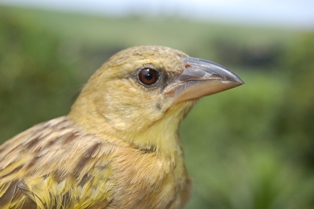
A team of ringers will be visiting ringing sites near St Lucia from 14 to 19 November. One of the aims is to ring Southern Brown-throated Weavers Ploceus xanthopterus (left: female). This species was first ringed in 1969 in southern Africa, by which time all other weaver species had been ringed. Only 429 have been caught in South Africa, although several thousand were ringed in Malawi (and by Mrs Dale Hanmer. Dale wrote an ageing and sexing guide for this species, based on her ringing experience. |
|
2010-10-29
Robben Island survey of weaver colonies 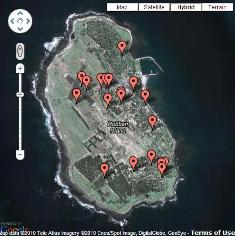
On 28 October 2010 Robben Island was surveyed for weaver colonies. A total of 19 Cape Weaver colonies were found. Colony size varied from 2 to 54 nests, with an average of 15. The peak breeding season has passed and some of the colonies appeared deserted. Few nests were low enough to reach without ladders; of the nests that could be checked one contained 2 small chicks and another had 2 eggs. In some high nests chicks were heard calling. The colonies were all in exotic trees, mostly Eucalyptus, but also in Manatoka or Pinus. The records were submitted to PHOWN (Photos of Weaver Nests) and may be viewed here. A mammal, reptile and two butterfly records were also added to the ADU Virtual Museums. The survey was conducted by Dieter Oschadleus and Victoria Odell by driving and walking around the island for most of the day. The total number of nests was 294 which is an increase to counts obtained in September and October 2003 (130 and 181 nests respectively, Oschadleus 2003). This suggests that the weaver population may have increased slightly over the last 7 years. Read more about Robben Island on the ADU web and Robben Island web. Reference: Oschadleus HD, 2003. Cape Weaver population on Robben Island. Bird Numbers 12(2):27-30 |
|
2010-10-15
PAPER: Ploceus cucullatus nigriceps ringed in South Africa Brooks A. 2010. Surprise Village Weaver. Afring News online 39:7-8 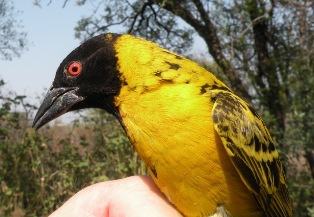
There is a new article for Afring News online by Alan Brooks, describing the ringing of a Village Weaver of a race not normally found in South Africa. Southern African birders are familiar with the yellow forehead of male Village Weavers in breeding plumage (race P. c. spilonotus) but race P. c. nigriceps has a black forehead and crown and is found in Zimbabwe, northern Botswana, Caprivi and northwards to Kenya. Although there are a few sightings of nigriceps in South Africa, this seems to be the first time that this subspecies has been ringed in South Africa. Read the article herePhoto: A Brooks. |
|
2010-10-13
The 10/10/10 challenge: 357 weaver nests counted 
350.org is an initiative to raise awareness of global climate change. This year one of the events that was planned for 10-10-10 (Sunday 10 Oct) was to count weaver nests and submit photos to PHOWN. The aim was to count at least 350 weaver nests together on Sunday, and this was achieved! A total of 357 nests were counted in 17 colonies, 38 nests belonging to Southern Masked Weavers and the rest to Cape Weavers. To see the individual records go here for the first record and then enter the following VM numbers one by one in the query box to see the rest of the records from Sunday: 136, 137, 138, 139, 140, 141, 142, 143, 144, 145, 146, 147, 150, 151, 152, 156, 212. Thanks to the following participants: Pat and Rodney MacKenzie (VM 147), Peter Ginn (VM 150-152) and Virginia MacKenny (VM 156) who helped me. Records were submitted for a wet Cape Town, Johannesburg, George, and Wolvengat. The latter colony (VM 156), on the Agulhas plains, is the southernmost weaver colony submitted to PHOWN so far. Colony sizes ranged from 2 to 46 nests. |
|
2010-10-08
Volunteer opportunity 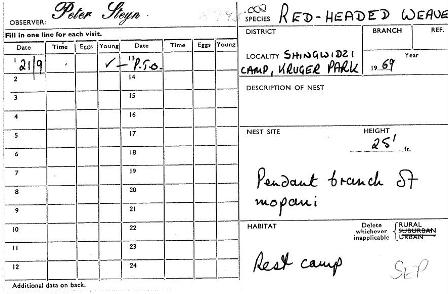
You can help with this project from home. Request some Nest Record Cards (NRCs) and these will be emailed to you as pdfs with an excel template into which the data needs to be filled in. For those with geographic skills, find the coordinates for the NRC. These records will ventually be added to the PHOWN database, providing historical records of weaver colonies, making this a very valuable resource. See more volunteer opportunities here. |
|
2010-10-08
The 10/10/10 challenge: action for climate change 
350.org is an initiative that started last year to raise awareness of global climate change. On 24 October 2009 the first 350 International Day of Climate Change and 350.org organised campaigns and events to raise awareness of increasing CO2 levels in the atmosphere. In South Africa, the 350-24-24 Bird Photo Challenge was organised to form part of this country's contribution to this campaign and photographers from around the country managed to photograph over 350 species of birds within 24 hours, a truly amazing achievement! This year even more events have been planned for 10-10-10 (Sunday 10 Oct). The Animal Demography Unit has 2 events that participants can take part in. Bird atlassers will aim to cover 350 pentads and anyone can contribute weaver nest photos to PHOWN. Let's aim to count at least 350 weaver nests together on Sunday. You can submit any number of colonies but try to keep a low carbon footprint since the idea of 350.org is to reduce carbon emisions! You may submit a new colony or a repeat photo and count of a colony you have previously submitted. PHOWN is registered at 350.org here (only one marker is possible on the 350.org map but you can submit photos from anywhere!). The total number of nests counted in PHOWN so far is 1797 nests (in 123 colony records, over the last 2-3 months). |
|
2010-10-02
PHOWN at the Stanford Bird Fair 
The Stanford Bird Fair has become an annual event since 2004 with a variety of bird talks, bird outings and other events. This year, after a talk on "Fascinating Weaver Nests", a group of birders went for a walk to record a Cape Weaver colony for PHOWN. The colony had about 35 nests, high up in a clump of poplar trees at the bottom of a garden. An old stick nest near some weaver nests was known to have belonged to Hadedas but was not currently active. There were 2 or 3 Cape Weaver males in the colony. See more details of this record here. Other colonies recorded at Stanford were records vm111, vm112 and vm113. |
|
2010-09-25
BOOK: Birds of Africa Sinclair I, Ryan P. 2010. Birds of Africa south of the Sahara. 2nd ed. Struik, Cape Town 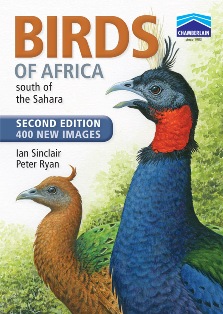
The authors have revised the 2003 edition to include 500 new images and improved maps. The major change in the weaver species is the inclusion of splits: Ploceus velatus split into velatus and vitellinus, and Ploceus reichardi into reichardi, ruweti and katangae. The plates are similar in both editions but there are 18 plates in the 2010 edition compared to 16 in 2003: one additional; plate is due to the taxonomic splits, and the other due to spacing out the widowbirds. A few additional pictures show an additional race for the Thick-billed Weaver and one additional race for the Black Bishop; there is an additional head for Viellot's Black Weaver showing eye colour variation. A new feature in the 2010 edition is having key identification features listed on the plates.
|
|
2010-09-24
A century of PHOWN records 
PHOWN reached the 100-record mark this week with a Cape Weaver colony submitted by Kevin Drummond-Hay, taken at De Grendal Wine Estate in the Western Cape, South Africa. Kevin counted 33 nests in the tree and took a photo with a cell phone. See more details of this record here. PHOWNs first newsletter is available here. Newsletters, highlighting interesting records, will be emailed at least quarterly but will also be available on the web. The Home page for PHOWN shows a gallery of the most recent photos - this gallery is automatically updated as new records are submitted and accepted. |
|
2010-09-15
PAPER: Unique Quelea predator Vincent LS, Breitman T. 2010. The scorpion Cheloctonus jonesii Pocock, 1892 (Scorpiones, Liochelidae) as a possible predator of the red-billed quelea, Quelea quelea (Linnaeus, 1758). Bulletin of the British Arachnological Society 15(2): 59-60 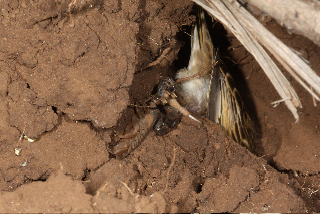
The authors found up to 8 Queleas each with one leg in a scorpion burrow, being held by a scorpion in a small area. The authors could not stay to see if the scorpions would exit their burrows to feed on the birds. Scorpions usually feed on invertebrate prey but also eat geckos, snakes, lizards and rodents. The scorpion Cheloctonus jonesii is a medium-sized, docile scorpion with very mild venom and endemic to the eastern region of South Africa.
Photo: Cheloctonus jonesii holding on to a Red-billed Quelea (Lenny Vincent) Abstract. Scorpions are reported for the first time predating on birds. In Kruger National Park, South Africa, we observed, in an area of approximately 20 m2, eight Cheloctonus jonesii Pocock, 1892. Each scorpion was in its burrow and had captured, by a leg, a juvenile red-billed quelea Quelea quelea (Linnaeus, 1758). |
|
2010-09-14
PAPER: Village Weavers' sweet tooth Odendaal TC, Brown M, Downs CT, Johnson SD. 2010. Sugar preferences and digestive efficiency of the Village Weaver, a key generalist avian pollinator of African plants. Journal of Experimental Biology 213: 2531-2535 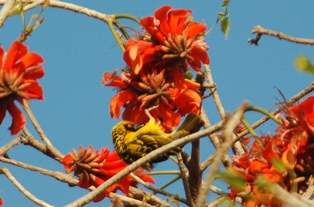
Village Weavers prefer hexose over sucrose sugar when offered dilute solutions. Interestingly, the weavers were able to maintain body mass on low concentrations, and met daily energy requirements, over a day. The authors suggest this could be a result of relatively slow transit times, allowing for better absorption at low concentrations. Photo:Village Weaver feeding on nectar of Erythrina in Southport, KZN, South Africa Abstract. Recent research has shown that nectar properties of flowers pollinated by generalist avian nectarivores differ markedly from those of flowers pollinated by specialist avian nectarivores. In particular, flowers pollinated by generalist avian nectarivores tend to have very dilute nectar dominated by hexose sugars. To establish whether pollinator-mediated selection can explain these traits, we tested nectar sugar preferences and digestive capabilities of the village weaver (Ploceus cucullatus), a common generalist passerine nectarivore in South Africa. When offered pairwise choices of equicaloric hexose and sucrose solutions, village weavers preferred hexose solutions at 5% and 10% sucrose equivalents (SE) but did not show significant preference for either type of sugar when higher concentrations were offered (15%, 20% and 25% SE). Birds were less efficient at absorbing sucrose than hexose sugars, as revealed by high-performance liquid chromatography (HPLC) analysis of excreta sugar content. This was true at both concentrations tested (8.22% and 25%), although apparent sucrose assimilation rates were still relatively high (89.6+-2.9% at low concentrations and 93.6+-1.7% at high concentrations). Transit times indicated that sucrose also passes through the digestive tract faster than hexose sugars, particularly when consumed at high concentrations. This may limit the rate at which sucrose can be hydrolyzed before absorption. These results indicate that hexose preferences in generalist avian nectarivores may help explain the low sucrose content in flowers pollinated by these birds. Moreover, the preference for hexose sugars in weavers was most evident at the low concentrations (ca. 9% sugar by mass) that are typical of nectar in flowers pollinated by generalist avian nectarivores. |
|
2010-08-25
Google Maps takes part in PHOWN ! View in Google Map Google Maps streetview has recorded weaver colonies close to roads that they photographed. One example is of a Cape Weaver colony at Rondevlei, Cape Town. Find the colony here and zoom in at the marker until the streetview appears. You can view the colony from different angles. About 13 nests are visible, but unfortunately no date is available for this record. This particular colony has been monitored since 2006 and several times photos were taken. These photos may be viewed at the ADU Virtual Museum - click on "Projects" in the menu on the left, click on the project header "Photos of Weaver Nests", then enter 70 in the "Search" box at the top to see the first record of this colony - enter any number from 70 to 75 to see all the current records of this colony, spanning from 2006 to recently. |
|
2010-08-19
How large are weaver colonies? 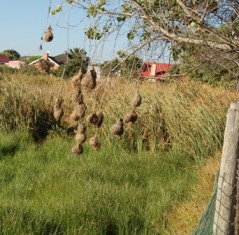
Weaver colony sizes vary between species with solitary species having 1 or 2 nests and colonial species may have over 100 nests in one colony. Single-male colonies, like Southern Masked Weavers, typically have less than 10 nests but sometimes this may be larger especially if there are more males than the usual one. One result of PHOWN (Photos of weaver nests) project is having a nest count per colony. To see up-to-date minimum, average and maximum colony sizes for records submitted to PHOWN click here. While birding, you can look out for weaver colonies and contribute photos with nest counts to the ADU Virtual Museum. As soon as your record is accepted, the average colony sizes will be automatically updated. To take part read here. |
|
2010-08-19
PAPER: Plumage and age effects in Male Southern Red Bishops Edler AU & Friedl TWP, 2010. Plumage Colouration, Age, Testosterone and Dominance in Male Red Bishops (Euplectes orix): A Laboratory Experiment. Ethology 116:806-820 Abstract. Visual signals such as plumage characteristics in birds often play a key role in the establishment of dominance in contests by acting as a badge of status that can be used to assess individual fighting ability. We studied the role of plumage colouration in males of the red bishop (Euplectes orix), a sexually dimorphic and polygynous weaverbird species occurring in sub-Saharan Africa and breeding in dense colonies around water. Males are highly territorial and often engage in competition over limited resources such as breeding sites and potential mates. By experimentally staging male-male contests over a limited food source, we wanted to determine whether the orange-red breeding plumage in this species serves as a dominance signal between individuals, with males with redder plumage being dominant over those with duller plumage. In the first set of experiments, we staged contests between unfamiliar and unmanipulated males. The setup of the second set of experiments was identical to the first, with the exception that those males with the lowest chroma and hue values had their plumage experimentally reddened within the range of the natural variation. In addition to plumage colouration, we incorporated testosterone levels, body condition and age into the analysis of factors contributing to contest outcome. Our results show a consistent and strong age effect in both sets of experiments, which seems to be independent of plumage colouration, testosterone and body condition. This suggests that in the red bishop, the outcome of male-male competitions over limited resources is determined by age-related acquired experience rather than by status signalling through plumage colouration.
|
|
2010-08-05
PHOWN - the furthest north colony 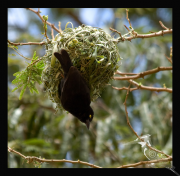
PHOWN (Photos of Weaver Nests) has started off well with 42 records submitted within the first week of the project. There are records for 20 weaver species. Most records are from South Africa, 3 from Namibia and 3 from Rwanda. The most northerly record is of a Vieillot's Black Weaver Ploceus nigerrimus, a colony of 6 nests in Rwanda, recorded by Claassen Marcell. You can view submissions (without being registered) by going here. There are different search possibilities - explore these yourself! To take part read here. |
|
2010-07-29
Phone in to take part in PHOWN ! 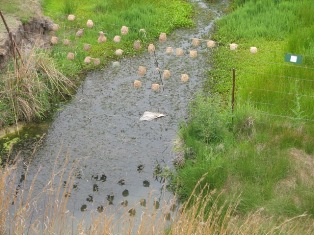
PHOWN (Photos of Weaver Nests; pronounced "phone") is a new ADU Virtual Museum project, where weaver nests or colonies may be photographed and submitted. To take part in this project, you need to register as an ADU participant. Then find weaver nests and take photos and count the nests. Read more details about how to take part by reading here. Any weaver species (Ploceidae family) may be photographed, including introduced populations that breed naturally in the wild. You can also take part in the other ADU Virtual Museums, all designed by Rene Navarro. You can view submissions (without being registered) by going here. There are different search possibilities - explore these yourself! There are already 23 records of a variety of southern African weavers. The first one submitted was by Les Underhill of Southern Masked Weavers breeding on a barbed wire fence. |
|
2010-07-19
PAPER: Eggs of cuckoos and host weavers 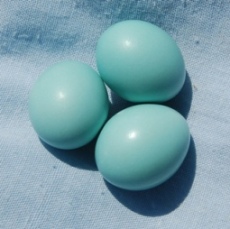
Spottiswoode CN, 2010. The evolution of host-specific variation in cuckoo eggshell strength. Journal of evolutionary Biology 23:1792-1799 Abstract. Cuckoo eggs are renowned for their mimicry of different host species, leading to the evolution of host-specific races (or 'gentes') defined by egg colour and pattern. This study aims to test the prediction that another property of parasitic eggs, namely shell strength, might also have experienced divergent selection within cuckoo species. Host races of the common cuckoo Cuculus canorus encountering stronger host rejection have thicker-shelled eggs than those parasitising less discriminating species, as expected if egg strengthening discourages host rejection. Moreover, in the diederik cuckoo Chrysococcyx caprius, eggshell thickness was correlated across cuckoo gentes and host species, as expected if eggshell strength has been involved in coevolutionary interactions. This is the first report of host-specific differences in cuckoo egg properties other than colour and pattern and lends correlational support to the hypothesis that the strong eggshells of brood parasites are an adaptation to reduce host rejection. Eggs of 16 weaver species were measured, including the blue eggs of Southern Red Bishops Euplectes orix. |
|
2010-07-02
SESAW - weavers in the balance 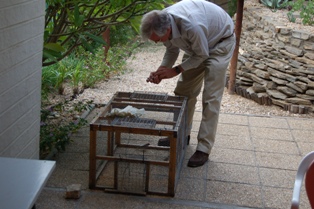
Most weaver species are common and in no need of conservation. Their common status, however, makes them easy to study and they are easy targets for ringers. SESAW (Survival Estimates in Southern African Weavers) is a project to monitor how survival rates are changing in weavers. Currently over 3500 weavers have been ringed and 9.4% of these have been retrapped in the first 10 months of the project. Read more here. This project has some differences to general SAFRING data: 1) all retraps are recorded - not all retraps less than 1 year were recorded in SAFRING in the past 2) recording breeding females and males in full breeding plumage will allow these 2 groups to be analysed in more detail - this is not possible with SAFRING data. In June Neil Thompson, ringing weavers and other birds in his Windhoek garden, caught 72 Southern Masked Weavers and Southern Red Bishops but as many 18 of these were recaptures. This changed the recapture rate for the whole project up from 9.1% to 9.4%. Neil uses mostly walk-in traps to catch the birds. |
|
2010-06-29
PAPER: Moult and biometrics of adult Southern Red Bishops 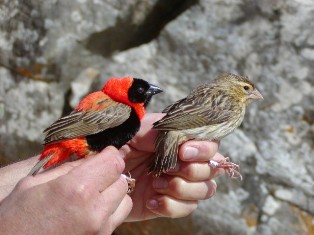
Craig AJFK, Bonnevie BT, Oschadleus HD. 2010. Regional patterns in moult and sexual dimorphism of adult Southern Red Bishops Euplectes orix in southern Africa. Ostrich 81:123-128. Abstract. Using the SAFRING database and the Underhill-Zucchini model of primary moult, we analysed the timing of wing moult in Southern Red Bishops Euplectes orix in relation to sex and geographical region. Birds from the winter rainfall region in the south-western sector of the Western Cape start the annual moult more than two months before any other population, but there were no significant differences in starting date within the summer rainfall region. There were striking differences in the estimates of moult duration (62-114 d), which did not follow a consistent pattern in relation to sex or geography; annual variation within a region may be an additional factor. Throughout southern Africa, both sexes showed a trend for longer-winged birds to take more time to complete their moult. We suggest that sex, geographical area and possible annual environmental variations may all influence the timing of moult in local populations. In this sexually dimorphic species, males are consistently longer-winged and heavier than females. |
|
2010-06-12
PAPER: Wintering ecology - Lesser Spotted Eagles and Red-billed Quelea 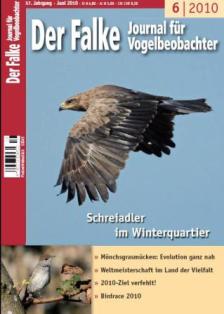
Meyburg, B.-U., J. Matthes & C. Meyburg (2010): Uberwinterungsokologie : Schreiadler und Blutschnabelweber. Der Falke 57: 236-243. This is a popular article written in German, mostly about Lesser Spotted Eagles feeding on Red-billed Quelea chicks in a breeding colony near Mopani camp in Kruger National Park. The author observed eagles opening the quelea nests with difficulty. Young eagles probably learn this from watching adults. The text has great photos of the eagles and of the quelea colony. One of the photos is of an eagle next to quelea nests - a unique sighting since the eagles are shy and careful in the thorny trees which hinder quick escapes. There are also maps of a satellite tracked adult Lesser Spotted Eagle. The mass of quelea is given as 29g, but this should be 19g. The literature gives the mean mass of quelea as 16 - 21 g and there does not appear to be much geographic variation in mass across the vast range of the species. Also in published works on chick growth, the mass of a chick is less than 20 g . Adult quelea lose about 12% of their mass overnight, so they need to feed sufficiently to make up for this every day. The article may be downloaded at Bernd Meyburg's web here and see more about his raptor research here. |
|
2010-05-27
Photograph the rarest weavers 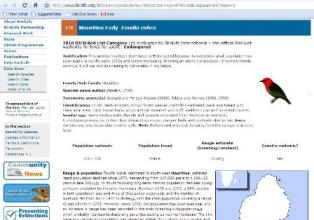
The World's Rarest project began in 2010 - the year proclaimed by The United Nations as the International Year of Biodiversity. The aim is to highlight the plight of the most threatened species on Earth and to raise funds for their conservation. The World's Rarest project will focus initially on birds and contribute to BirdLife International's Preventing Extinctions Programme. The project starts with the launch of an exciting photo competition, which will provide the images for a new book entitled The World's Rarest Birds. The weavers you can photos of are 7 Endangered species: Bates's Weaver Ploceus batesi, Clarke's Weaver Ploceus golandi, Golden-naped Weaver Ploceus aureonucha, Usambara Weaver Ploceus nicolli, Gola Malimbe Malimbus ballmanni, Ibadan Malimbe Malimbus ibadanensis, and Mauritius Fody Foudia rubra. There is one weaver in the Data Deficient category: Lake Lufira Weaver Ploceus ruweti. Read more here. |
|
2010-05-26
Thermal tolerances of Southern Red Bishops 
Tanja is a student at the Nelson Mandela Metropolitan University who has an M.Sc. project on thermal tolerances of Southern Red Bishops. Tanja will capture bishops for metabolic rate measurements in two different locations: one with a mild coastal climate (Port Elizabeth) and the other location inland where seasonal and daily temperatures are extreme (Barkly East). Bishops in Barkly East will be captured between 22 July - 31 July 2010 with help from ringers Pat Cochran and Graham Grieve and trainees Liaan Minnie and Ryan Wasserman. Albert Schultz will help capture bishops in Port Elizabeth. |
|
2010-05-25
Red-billed Quelea sighting 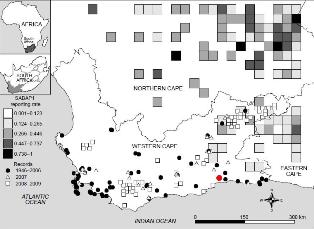
"I went out ringing at one of my usual sites this weekend which is in a reed bed which gives me loads of Cape Weaver, Red Bishops and a numbers of other common reed bed species. I've been ringing there quite frequently since 2007 and up until now nothing out of the ordinary has cropped up. On Saturday I was fortunate to ring six Red-billed Quelea, I know that these birds have been seen more and more frequently in the Western Cape and the Karoo but up until now I haven't spotted them on the southern side of the Outeniqua Mountain range. As you all know we are having the worst drought in 130 years, so one wonders if these dryer conditions are more attractive or there are any other factors which are influencing this movement of the species. It will be interesting to see if they stick around when we do finally get our much needed rain."
Continue sending in sightings of quelea in the Western Cape see here |
|
2010-05-19
Namibian ringers get-together, Kakuse farm, 13-16 May 2010 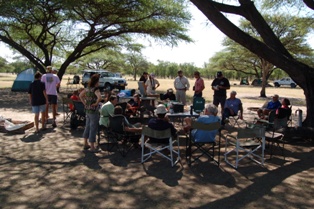
36 people attended the 2010 Namibian ringers' get-together (RGT) at Kakuse farm near Tsumeb. The first RGT was held at Wiese farm in 2004. Nearly 300 birds were ringed with Blue Waxbills and Red-billed Quelea being the most often caught species. Not all ringers came to ring birds, however; some attended simply to enjoy the wonderful social atmosphere at these get-togethers. Read more about this event here. Weavers that have been ringed here previously are White-browed Sparrow-weaver, Southern Masked Weaver and Red-billed Quelea. Red-billed Buffalo Weavers breed here. Chestnut Weavers have visited but were not seen on this visit. |
|
2010-05-19
Rufous-chested Sparrowhawk 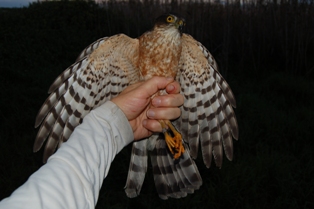
In targetting weavers to study their movements, other birds are also caught. This morning a Rufous-chested Sparrowhawk (probably a sub-adult female) flew into my mist net at dawn in Kommetjie. There is a large roost with mainly Cape Weavers and some Southern Masked Weavers. When the sparrowhawk flew past, the weavers stopped their morning chorus. While ringing the sparrowhawk, the weavers quickly left the roost in some large flocks and later in smaller flocks. The Rufous-chested Sparrowhawk has been recorded catching weavers as prey, including Cape and Southern Masked Weavers. Thus the weaver chicks that have been ringed on the Peninsula are potential prey of this small raptor. Several weaver chicks have been recaptured at this site: read more about this project here. The captured sparrowhawk did not catch any early weavers, but nor did I on this session! |
|
2010-05-07
PAPER: The Lubango Bird Skin Collection 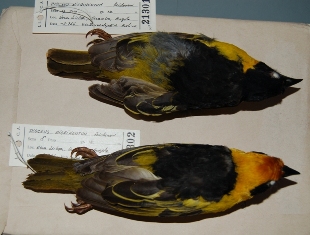
Mills MSL, Franke U, Joseph G, Miato F, Milton S, Monadjem A, Oschadleus D & Dean WRJ 2010 Cataloguing the Lubango Bird Skin Collection: towards an atlas of Angolan bird distributions. Bulletin of the African Bird Club 17: 43-53 Abstract. The bird collection housed in Lubango, Angola, contains more than 40,000 skins, representing more than 850 taxa. As part of an atlas project for Angolan birds, we visited the skin collection for two weeks in June 2008, to extract distributional information from the specimens. The skin collection is still in good condition, and the Instituto Superior da Ciências e Educação (ISCED), which houses the collection, is to be commended for this. Data from labels of 15,000 skins were entered into an electronic database, including all specimens of lesser known species. The remaining 25,000 entries are being made from photographs of ‘catalogue’ cards. The most interesting specimens are four Slaty Egrets Egretta vinaceigula, the first records of this globally Vulnerable species in Angola. Other examples of interesting skins are illustrated in various photographs, drawing attention to the importance of the collection for systematic studies. A brief mention is also made of the mammal collection. Finally, a list of recommendations is given for the future management of the collection. Most Angolan weavers are represented in the collection, notable exceptions being Orange Ploceus aurantius and Slender-billed Weaver P. pelzelni. The collection generally contains few types, but it does house the type series of the subspecies of Scaly-feathered Finch Sporopipes squamifrons pallidus described by Pinto (1967). Several rare or uncommon weavers are represented: Black-chinned Weaver P. nigrimentus (2) [see photo: female with black head], Loango Weaver P. subpersonatus (2), Brown-capped Weaver P. insignis (5), Black Bishop Euplectes gierowii (1 from Tanzania) and Golden-backed Bishop E. aureus (47). Three specimens of Southern Masked Weaver Ploceus velatus were collected by Pinto from the isolated Lake Dilolo during August 1958. The nearest locality to Dilolo for Southern Masked Weaver is in north-west Zambia. Contents for this issue of the Bulletin of the African Bird Club |
|
2010-05-06
Ringing course in Port Elizabeth 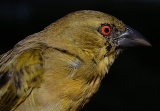
This week BirdLife Eastern Cape is celebrating their 60th anniversary. One of the events is a ringing course organised by ringer Albert Schultz. So far about 300 birds have been caught. The most common birds caught so far were Cape Bulbul, Lesser Swamp Warbler, Bar-throated Apalis, Common Waxbill, Sombre Greenbul and Southern Masked Weaver. Ringing sites were mostly at Cape Recife, and also at Settlers Park, The Island Forest and Thunzi Lodge.
|
|
2010-04-16
PhD completed - Phylogeny and plumages in widowbirds and bishops 
Maria Prager completed her PhD in animal ecology, entitled "Phylogeny and Signal Diversity in Widowbirds and Bishops (Euplectes spp.)", at the University of Gothenburg, Göteborg, Sweden. Her thesis contains an overview and five papers (four published, one provisionally accepted). Maria defended her thesis on 12 March 2010. Maria found the genus Euplectes to be monophyletic. There was a distinction between the 'true' widowbirds (long tails, small colour patches) and bishops (short tails, large colour patches). However, the Red-collared Widowbird E. ardens was an exception as it belongs to the bishops rather than to the widowbirds. Also the Yellow Bishop E. capensis is actually a widowbird, as reflected in its previous name 'Yellow-rumped Widow'. The ancestral species probably had short tails and yellow plumage patches, and some species evolved long tails and redder colours (the red hues being gained via different mechanisms in different species). The Southern Red Bishop E. orix is able to manufacture red pigments from yellow precursors in its seed diet, while the Yellow-crowned Bishop E. afer is not able to do this. Maria's supervisor is Prof. Staffan Andersson who's long-term project is to study the behavioural ecology, physiological mechanisms and evolutionary diversification of carotenoid pigmentation in African widowbirds and bishops (Euplectes spp.) and other weaverbirds (Ploceinae). To allow phylogenetic comparative studies of social and ecological selection pressures and constraints on colour evolution, a molecular phylogeny of the studied taxa is being estimated from mitochondrial and nuclear genes. |
|
2010-04-16
WEB: Range changes in African birds Africa Climate Exchange (ACE) Species list - maps Scroll down to Ploceidae for a list of weaver maps This website shows current distribution maps of African birds and how these distributions may change due to climate by 2025, 2055 and 2085. Many current maps have dots where the species does not occur (eg White-winged Widow does not occur in Cape Town). Many weavers are predicted to arrive along the east coast of South Africa in the future, although there is a wide gap between the rest of the bird's future range - this modelling does not seem believable. Some examples of this are Ploceus baglafecht, Ploceus angolensis, Ploceus nigricollis, Ploceus rubiginosus, Ploceus superciliosus, Malimbus malimbicus, Euplectes diadematus and Ploceus taeniopterus. Interestingly Red-headed Weavers and Red-billed Buffalo Weavers are predicted to arrive in Cape Town even though these are savanna species. Species will certainly change their ranges in the future but any long term predictions are unlikely to be correct since range changes depend on more than future environments, but also ecological interactions (like diet). |
|
2010-04-14
PAPER: Differences in the timing of primary moult Bonnevie B, Oschadleus HD. 2010. Timing of primary wing moult in sexually dimorphic passerines from the Western Cape, South Africa. Ostrich 81: 63-67 Abstract. SAFRING ringing data was used to investigate the differences in the timing and duration of primary wing moult between males and females of sexually dimorphic passerines from the Western Cape, South Africa. In the sunbirds, weavers and canaries that were considered, the males generally started moult before the females, whereas this was not so for other species. In the species where males started moult before the females, the standard deviation of the start of moult was generally smaller in the males and the males generally took longer to moult. These differences in the patterns of moult are discussed in the context of differences in parental care between males and females of each species and within their taxonomic groups. Cape Weaver, Southern Red Bishop and Yellow Bishop males started moult 1 to 3 weeks earlier than females and males took longer to moult. Southern Masked Weaver males started a week later than females, but this difference was not significant. |
|
2010-04-08
PhD position - colour radiation in weaverbirds There is a post for a biologist interested in doing a PhD in animal ecology, entitled "Colour signalling and adaptive radiation in African weaverbirds", at the University of Gothenburg, Göteborg, Sweden. The PhD-position starts in June 2010 (or as agreed upon) and the application deadline is 30 April 2010. The main supervisor is Prof. Staffan Andersson who has a spectacular study site at the epicentre of Euplectes diversification in Tanzania. Application details are available here. Prof. Andersson's long-term project is to study the behavioural ecology, physiological mechanisms and evolutionary diversification of carotenoid pigmentation in African widowbirds and bishops (Euplectes spp.) and other weaverbirds (Ploceinae). To allow phylogenetic comparative studies of social and ecological selection pressures and constraints on colour evolution, a molecular phylogeny of the studied taxa is being estimated from mitochondrial and nuclear genes. |
|
2010-04-07
PAPER: Quelea lice Sychra O, Barlev E, Literak I, Capek M, Koubek P, Prochazka P. 2010. The chewing lice (Phthiraptera) of red-billed quelea (Quelea quelea) in Senegal, with a description of a new species: research article. African Entomology 18:17-22 Abstract. One hundred and six individuals of red-billed quelea (Quelea quelea) were examined for chewing lice (Phthiraptera: Amblycera, Ischnocera) in Senegal. Chewing lice were found on 91 (86 %) birds examined. Three species of chewing lice were identified; they had the following prevalences and mean intensities : Brueelia queleae n. sp. (81 %; 5.3 lice), Myrsidea queleae (37 %; 1.7) and Machaerilaemus plocei (9 %; 1.7). These are the first records of chewing lice from red-billed quelea from Senegal. A new species of Brueelia is described and illustrated. This is the first ischnoceran louse described from this host. Note: The authors also state that they recorded the second case of a Brueelia louse on a ploceid. Actually their record is the fourth species of weaver found with Brueelia lice, the previous three being Southern Masked Weaver (Johnson et al. 2002), Lesser Masked Weaver and Southern Red Bishop (Lindholm et al. 1998). |
|
2010-03-31
Werkgroep voor Ploceidae "Werkgroep voor Ploceidae" is a group of enthusiasts that keep weavers in aviaries in the Netherlands. See their web here. Under News (Nieuws) there are photos of their recent annual meeting. |
|
2010-03-29
PAPER: Cape Weaver parasites Schultz A, Underhill LG, Earlé RA, Underhill G. 2010. Infection prevalence and absence of positive correlation between avian haemosporidian parasites, mass, and body condition in the Cape Weaver Ploceus capensis. Ostrich 81: 69-76 Abstract. Over a two-year period, 945 adult Cape Weavers Ploceus capensis were mist-netted with a bias towards 632 male and 308 female birds. Blood smears presented avian haemosporidia in 58.79% of males and 61.90% of females, representing five species from three genera: one avian kinetoplastid haemoflagellate Trypanosoma everetti with 0.28% infection rate, Haemoproteus queleae (69.45%), Leucocytozoon bouffardi (23.91%), and Plasmodium species (5.76%). Double infections occurred in 40 birds (11.52%), with females having the greatest number. Differences in infection prevalence between sexes was correlated to time spent being active at the nest, with a marked reduction in female infection due to incubation within a tunnel-shaped nest providing protection from vectors. Commencement of the breeding season coincided with increased parasite prevalence in both sexes, correlating to energy expenditure on reproductive effort, resulting in reduced immunocompetence. Recorded seasonal spring relapse is synchronised with peak breeding season activity, when vector intensity and activity peak due to host population increases, and avian immunodefence systems are possibly compromised due to the stress of the reproductive cycle. No negative impacts were discerned on body mass or condition during this long-term study, which may be presented when parasitemia peaks over a number of days only, thereafter decreasing in intensity. |
|
2010-03-23
Report of Barberspan Ringers Conference and travels to the BLSA AGM The period 11-21 March saw successful days of ringing and bird talks. At Barberspan Bird Sanctuary 1610 birds were handled of 82 species. Birds not ringed at Barberspan previously were Darter (10 chicks), Cloud Cisticola, and Crimson-breasted Shrike. Of the retraps already reported, the greatest elapsed time was for 2 White-browed Sparrow-weavers ringed in June 2008. Top species caught were Southern Red Bishop (743), Red-billed Quelea (183), Southern Masked-Weaver (128), Kittlitz's Plover (70), and Egyptian Goose (38). About 300 birds were ringed at Wakkerstroom over 2 days to demonstrate ringing to birders attending the BLSA AGM. Ringers Rina Pretorius, Sylva Francis (with trainee Michael), Yahkat Barshep and Doug Harebottle helped with the ringing. The retrap with the greatest elapsed time was a Southern Red Bishop ringed on 07/01/2005. Brief reports of these events may be seen as a web report and SAFRING news items. |
|
2010-03-09
Cape Weaver movements on the Cape Peninsula Most resident passerines on the Cape Peninsula seem to move very little, based on ringing several thousand birds over several years. The exceptions are nectarivores and Cape Weavers, all of which show extensive movements, probably in relation to food supplies. A map of Cape Weaver movements has lines linking the top left corner of the grids (and not actual points of capture) where the weavers were caught and recaptured.
|
|
2010-03-08
Rwanda Bird Atlas The most recent bird atlas project in Africa is the Rwanda Bird Atlas. Bird atlas projects provide detailed distributional snap-shots of weavers and other birds. Read more here - scroll down to the Atlas post. Other current African bird atlas projects include South Africa (all weaver species mapped) and Tanzania (some weaver species mapped).
|
|
2010-03-01
Baglafecht Weaver plumages The Baglafecht Weaver has 8 distinct races, some of which have been considered separate species. Some races have an eclipse plumage while others retain the same plumage all year. All or most races intergrade. Usually the eye is pale and it has a black face, but the headand back colours vary (young birds probably all have dark eyes and paler faces). The species is found from central to East Africa, and is a monogamous breeder. A variety of plumages is illustrated from Rwanda and Kenya here. |
|
2010-02-23
28 weaver chicks recaptured After the first few months of mist-netting, 28 weaver chicks have been recaptured at roosting or foraging sites. Most of these were Southern Masked Weaver chicks. Cape Weaver chicks have dispersed the furthest, with 5 chicks dispersing 0.9 to 14.3 km. The maximum dispersal for Southern Masked Weaver and Southern Red Bishop chicks is about 1 km, with many chicks being recaptured close to where they had fledged. Read more here, where results will be updated regularly. |
|
2010-02-08
Red-headed Weaver ringing trip The first week of Feb 2010 involved a short trip to Platjan farm on the Limpopo River to ring primarily Red-headed Weavers, as well as other weaver species. Most Red-headed Weavers have completed breeding by February but a large active colony was found on Mayholme farm, south of Platjan. Several hundred nests were counted in the syringa and baobab trees around the main farm house. Some 75 Red-headed Weavers were caught including two recaptures from 2007. In addition, 9 chicks were ringed in nests that were low enough to reach. This is the most number of Red-headed Weavers ringed in one day. Only 394 Red-headed Weavers had been ringed or retrapped in southern Africa over the last 60 years, so this provided a substantial increase. These are also the first Red-headed Weaver chicks ringed in southern Africa (one has been ringed in Zambia). Read more about the trip here. |
|
2010-02-01
SESAW: Survival Estimates in Southern African Weavers This project is continuing to progres well and has been running for 5 months. The study aims to estimate survival rates of weavers in different parts of southern Africa, and relies on ringers ringing and recapturing weavers. The most ringed weaver species is now the Southern Masked Weaver (985) although it has a low recapture rate (5.6%). In second place is the Southern Red Bishop (820 ringed). The Spectacled Weaver has the highest recapture rate (36%). Read more here. |
|
2010-01-22
Weavers and waterbirds, Jan 2010 Catching weavers results in also catching other birds, and in wetland areas that may mean waterbirds! See photos of the waterbirds here. From January there is frequent ringing in order to recapture chicks ringed last year. The first 3 weeks of January have yielded 152 birds, of which 64 were weavers. Of these 4 were juvenile weavers that had been ringed as chicks near the site of recapture. One juvenile was a Southern Red Bishop, and the other 3 were Southern Masked Weaver chicks. The latter were all from the same nest and were caught with an adult female - they were seen flying into the net at the same time, indicating that the juveniles (3 weeks old) were still dependent on their mother. |
|
2010-01-21
PAPER: Southern Red Bishop plumage Edler AU & Friedl TWP, 2010. Individual quality and carotenoid-based plumage ornaments in male red bishops (Euplectes orix): plumage is not all that counts. Biological Journal of the Linnean Society 99:384-397 Abstract. Males in many bird species develop elaborate carotenoid-based plumage ornaments that play an important role as signals of individual quality in intra- or intersexual selection. In the present study, we investigated which of several factors related to male condition and health affect the brightness and coloration of the carotenoid-based orange-red breeding plumage in males of the red bishop (Euplectes orix), a polygynous and sexually dimorphic weaverbird species. The study revealed a very complex pattern, with the relationships between plumage traits and both heterophil-to-lymphocyte ratio and blood parasite load varying considerably among seasons, suggesting a strong influence of environmental conditions. Furthermore, overall condition of males strongly affected the association pattern between plumage traits and other factors, with males in bad condition being forced to allocate resources away from plumage elaboration to body maintenance or the enhancement of immune functions, whereas males in good condition can afford to invest in plumage ornamentation without obvious detrimental effects on health. Thus, females cannot rely on plumage characteristics alone to gather information on male quality, but have to assess additional traits that advertise general male health status. Perhaps surprisingly, testosterone levels were not related to male plumage characteristics. |
|
2010-01-15
Gabar Goshawk attack on weavers "Camping for a weeks in Maun, Botswana, November 2009, in a Mopane forest, my closest neighbours, 50 cm above my roof tent, were 3 inhabited nests with Red-headed Weavers (Anaplectes rubriceps). Other neighbours nearby were a colony of at least 50 breeding pairs of Red-billed Buffalo-Weavers (Bubalornis niger), 2 pairs of Lilac-breasted Rollers (Coracias caudatus) and at least 2 pairs of Broad-billed Rollers (Eurystomus glaucurus).
Dag Gjerstad, Cape Town, 15/01/2010
[published in Gabar 21:68, 2010] |
|
2010-01-07
PAPER: Yellow Bishop type specimen Oschadleus HD. 2009. Type specimen of Euplectes capensis macrorhynchus (Aves). Annals of the Transvaal Museum 46:113 This short note corrects an error in the published catalogue of avian types in the Transvaal Museum (Dean WRJ 2007, Type specimens of birds (Aves) in the Transvaal Museum collection, Annals of the Transvaal Museum 44: 67-121). The holotype for Yellow Bishop Euplectes capensis macrorhynchus is specimen TM 11811, and TM 11810 is a paratype, both from Klawer near Vanrhynsdorp, in the Western Cape, and collected by Austin Roberts in September 1917. |
|
2010-01-06
Greatest longevity for Dark-backed Weaver A one day ringing visit to Landela (Cloughside farm), between Port Elizabeth and Uitenhage, resulted in the recapture of Dark-backed Weaver BH34002, a female first ringed by Mike Ford on 11/10/2004 at the farm. It was recaptured on 16/11/2005 during a SAFRING national ringing workshop Landela. BH34002 was caught again, this time with a juvenile, on 06/01/2010 (Thanks to Eugene & Renee Cooney for their hospitality!). The elapsed time was 5 years 3 months, making it the greatest longevity for this species in the wild. The Dark-backed Weaver may be expected to achieve much higher longevities, however, as relatively few have been ringed in Africa to date. It has reached 10 years in captivity.
|
|
2010-01-02
2000 birds ringed on the Cape Peninsula in 2009 Over 2000 birds were ringed on the Cape Peninsula in 2009, of 40 species. Two thirds of these consisted of four weaver species. The top four species ringed were Cape Weaver, Southern Masked Weaver, Southern Red Bishop and Common Waxbill. The highest recapture rate (where at least 10 birds were ringed) was for Levaillant's Cisticola. A full species list of captures on the Cape Peninsula is given here. To join bird ringing events in Cape Town in 2010, check dates on this calendar. |
|
2009-12-13
PAPER: Red-billed Quelea irruption Oschadleus HD, 2009. An irruption of Red-billed Quelea Quelea quelea in the Western Cape province, South Africa. Ostrich 80:193-196 Abstract. The Red-billed Quelea Quelea quelea has been steadily expanding its range into the Western Cape province. The earliest record is of a vagrant in 1946. The next record came from 1986 in the Karoo and since 1997 there have been annual reports of the species in the province. It has become resident in the Karoo, especially in the Beaufort West to Leeu Gamka area. In April and May 2007 there was an invasion of Red-billed Queleas in the Western Cape province, particularly on the Cape Peninsula and Overberg region. Sixty-eight percent of records were within 5 km of the coast, over a stretch of 1 000 km of coastline. Adult males in breeding plumage were frequently observed, indicating that this irruption was not limited to post-juvenile dispersal. This influx was not repeated in 2008, but from April 2008 to January 2009, monthly records of queleas were higher than the combined monthly totals in years prior to the influx. The increasing occurrence of queleas in the Western Cape province is a potential threat to a major wheat-producing area and continued monitoring is required. Recent sightings are listed on the web here. Email author to request pdf of paper. |
|
2009-12-04
Red-billed Quelea flies 1735 km just to be eaten! On 27 October 2009 a group of South Africans visited Rovuma Village near Balama, Cabo Delgado in Mozambique. They were part of a group of 4x4 enthusiasts on a 5 week venture. Late in the afternoon some local women were busy cooking and one of them brought a metal object to the South Africans. The metal ring had been found in one of the pots used for cooking soup, and was inscribed with a SAFRING number AM62067.
This bird (Quelea quelea) had been ringed on 27 January 2007 as an adult female at Nokeng Buffelsdrif in Pretoria (25°35'S 28°20'E) by Chris du Plooy. The ring recovery was reported on 29 October 2009 from Rovuma Village (13°18'S 38°34'E) by Eric Dry. This bird moved 1735 km in 2 years 9 months.
|
|
2009-11-30
Lesser Masked Weavers in Durban "In Kwazulu Natal, a pair of Lesser Masked Weavers have been discovered breeding at Mount Edgecombe Estate in Durban and were showing well on Monday. They were apparently only discovered at this site last year for the first time and are evidently an extremely rare bird in the Durban area with not a single record during the first bird atlas project." Extract from SA Rare Bird News Report - 26 November 2009 (David Allan).
|
|
2009-11-23
Western Cape ringing social, 21 Nov 2009 On Saturday 11 ringers and trainees gathered from 5am at Intaka Island, Cape Town, to ring birds. Attendees were Margaret McCall, Lee Silks, Phoebe Barnard, Jo Johnson, Eric Barnes, Cassy Sheasby, Carol Milan, Damian & Calvin Gibbs, Dieter & Tandy Oschadleus. A total of 192 birds were caught, not counting same-day recaptures, of 19 species. The top 3 species caught were Cape White-eye (49), Southern Red Bishop (47), and European Starling (25, mostly juveniles!). Some photos may be viewed here.
|
|
2009-11-19
Kirstenbosch Summer Sunset Concert Series The 2009-2010 Kirstenbosch Summer Sunset Concert Series starts on 22 November 2009, and various environmental organisations will exhibit their projects at these concerts, culminating in the main Biodiversity Expo on 25-28 March 2010. The Animal Demography Unit (ADU) will be exhibiting several projects on 22 Nov at the first concert for this season. Come early to the concert by Johnny Clegg and see the ADU displays, including a Ringing demonstration and weaver nests display. Read more about the Concerts and Biodiversity Expo here. |
|
2009-11-12
Birds and Environmental Change A 16 page booklet titled "Birds and Environmental Change: building an early warning system in South Africa" has been produced by South
African National Biodiversity Institute (SANBI) and the Animal Demography Unit (ADU) of the University of Cape Town, with the financial support of the Royal Danish Embassy, Pretoria. There are 9 case studies, mostly of birds but one study is of the Prince Edward Islands. The Red-billed Quelea features as a bird that is expanding its range in the Western Cape in response to environmental changes in South Africa (see page 6 of the booklet). A pdf is available here.
|
|
2009-11-01
Chick ringing - the first 3 months The first 3 months of the 'natal dispersal' project have elapsed and here is a quick rundown of the stats for 1 August - 31 October. A total of 401 chicks have been ringed. The effort to reach this number was 2657 kms driven and 160 hours spent driving, searching for, and ringing chicks. On average it took 6.6 km and 24 minutes to ring each of these 401 chicks. The northern most chicks were ringed at the Diep River near Blauuberg Road and the southernmost chicks in Kommetjie, a north-south distance of 37 km (but much further by road). Monthly totals of ringed chicks may be found here.
|
|
2009-10-26
Photo gallery of bird ringing in Cape Town 2009 A photo gallery showing bird ringing events in the Cape Town area may be viewed here. The photos illustrate community involvement in ringing especially school children and students. The ringing events include mist-netting as well as ringing chicks. Watching bird ringing events gives insights into birds that are not readily apparent during normal bird watching, and participants are able to hold and release birds after ringing. To join bird ringing events in Cape Town, check dates on this calendar. Also check out the gallery regularly for updates of more interesting photos. |
|
2009-10-25
PAPER: Nest morphology in African weaver birds Walsh PT, Hansell M, Borello WD, Healy SD, 2009. Repeatability of nest morphology in African weaver birds. Biology Letters, online Abstract. It is generally assumed that birds build nests according to a genetic 'template', little influenced by learning or memory. One way to confirm the role of genetics in nest building is to assess the repeatability of nest morphology with repeated nest attempts. Solitary weaver birds, which build multiple nests in a single breeding season, are a useful group with which to do this. Here we show that repeatability of nest morphology was low, but significant, in male Southern Masked weaver birds and not significant in the Village weavers. The larger bodied Village weavers built larger nests than did Southern Masked weavers, but body size did not explain variation in Southern Masked weaver nest dimensions. Nests built by the same male in both species got shorter and lighter as more nests were constructed. While these data demonstrate the potential for a genetic component of variation in nest building in solitary weavers, it is also clear that there remains plenty of scope in both of these species for experience to shape nest construction. |
|
2009-10-14
Movement of a Cape Weaver chick On 17 October 2009 a juvenile Cape Weaver with ring CV43096 was recaptured at Mocke River wetland in Cape Town. The ringing event was a ringing demonstration for the SACS Junior School Enviro Club, organised by Lynne Roscoe. The bird had been ringed as a chick at Athlone Sewage Works on 26/08/2009 in a nest with two chicks. The chick probably fledged about a week after ringing, and dispersed 10.5 km in about 6 weeks. Read more about the dispersal of weaver chicks here. |
|
2009-10-14
SESAW: Survival Estimates in Southern African Weavers This project is progressing well, after just 2 months. The study aims to estimate survival rates of weavers in different parts of southern Africa, and relies on ringers ringing and recapturing weavers. The most ringed weaver species is the Southern Red Bishop (169) and it also has the highest recapture rate (15%). Other species with over 100 ringed are Cape Weaver and Southern Masked Weaver. Read more here. |
|
2009-10-09
Welcome to Christian Escher, University of Munich We welcome Christian Escher, a student of the University of Munich in Germany. He is visiting Cape Town for two weeks from 7 Oct. His supervisor, Dr Alain Jacot of the Max Planck Institute for Ornithology, is working on variation in begging calls of colonially and solitary breeding weaver species. The aim of Christian's visit is to obtain recordings of chicks close to fledging (day 13 and older), and to obtain recordings of nestlings of different ages. Another PhD student, Hendrik Reers, presented data from Kenya on weaver calls at the PAOC: read abstract here
|
|
2009-10-02
Movements of weaver chicks During August and September 2009 over 200 weaver chicks were ringed in an on-going project to ring chicks and later recapture as many of them as possible to determine their natal dispersal. Three Southern Red Bishop chicks were ringed at Intaka Island (Century City) on 04/09/2009 about a week prior to them fledging. One of these fledglings was killed by a cat in a nearby garden on 30/09/2009, about 1km from the nest site. It was reported by Sally Terry who had earlier noticed that the fledgling was still being fed by an adult Southern Red Bishop.
These are the first 2 records of movements of chicks ringed in 2009. Many more chicks will be ringed and mist-netting sessions in 2010 will attempt to recapture surviving birds.
|
|
2009-09-19
Weaver identification, ageing & sexing Several papers about weaver identification, ageing & sexing have been published in Safring News. Many of them can be downloaded here as pdf files (the rest of the pdfs will be added soon). |
|
2009-09-16
Calendar of weaver ringing events in the Cape Town area Anyone wanting to join in for ringing events in the Cape Peninsula, can click on this calendar. Some events are planned far in advance (weather dependant) while some are planned at short notice (even a day prior to the ringing session), so check frequently. The focus is on ringing weavers to study their movements and survival, but any wild birds that are caught will be ringed. On the calendar web page there are links to results of previous ringing, showing numbers and species of birds ringed recently. The pages with results also acknowledge the many ringers and helpers! |
|
2009-09-16
PAPER: Tail length in widows and bishops Prager M & Andersson A, 2009. Phylogeny and evolution of sexually selected tail ornamentation in widowbirds and bishops (Euplectesspp.). Journal of evolutionary Biology 22:2068-2076 Abstract. Despite similar ecology, mating systems and female preferences for supernormal tails, the 17 species of African widowbirds and bishops (Euplectes spp.) show astonishing variation in male tail ornamentation. Whereas bishops retain their brown nonbreeding tails in nuptial plumage, widowbirds grow black nuptial tails, varying in length from a few centimetres in E. axillaris to the extreme half metre train of E. progne. Here, we phylogenetically reconstruct the evolution of the discrete trait, nuptial tail and the continuous trait, tail length, using a molecular phylogeny of 33 Euplectes subspecies. Unlike many recent findings of labile evolution of plumage ornaments, our results suggest that the nuptial tail of Euplectes is a derived and phylogenetically conserved ornamental trait that, once gained, shows directional evolution in its expression. Directionality is demonstrated in the trivial sense of a short-tailed ancestor, and by contingency and randomization tests suggesting that branches with increasing tail length are overrepresented. This supports an early origin and strong retention of directional female mate choice in widowbirds and bishops, as previously indicated by empirical and experimental results, and provides a less labile, yet rapid scenario of sexually selected diversification. |
|
2009-09-03
PAPER: Rediscovery of the Lake Lufira Weaver Louette M & Hasson M 2009. Rediscovery of the Lake Lufira Weaver Ploceus ruweti. Bulletin of the African Bird Club 16:168-173 Abstract. The Lake Lufira Weaver Ploceus ruweti, known previously solely from the holotype collected at Lake Lufira (= Lake Tshangalele) in Katanga, south-eastern Democratic Republic of Congo (Congo-Kinshasa), in 1960, was rediscovered nesting at the same locality in February - March 2009. In this paper colour photos are provided of adult birds, a juvenile, the nest and eggs, and habitat of the species. Download the paper here. |
|
2009-08-04
PAPER: Weaver specimens in northern Mozambique Dean WRJ & Milton SJ 2007. Avifaunal specimens from northern Mozambique in museum collections. Durban Museum Novitates 32: 1-37 Abstract. Collection details and taxonomy are given for 3573 specimens of 421 species of birds collected in northern Mozambique. The taxonomy has been updated to include species splits and synonymies, and the most recent opinions on monotypic and polytypic species. Specimen data from from northern Mozambique (north of 18°S) from 23 museums are included. The paper gives localities with 15°x15° grid and month of collection for each species - year of collection is not provided. The weavers with specimen data (23 species) are: White-browed Sparrow-Weaver, Lesser Masked Weaver, Spectacled Weaver, Yellow Weaver, Bertram's Weaver, Holub's Golden Weaver, Southern Brown-throated Weaver, Southern Masked Weaver, Village Weaver, Dark-backed Weaver, Olive-headed Weaver, Red-headed Weaver, Red-headed Quelea, Red-billed Quelea, Zanzibar Bishop, Fire-crowned Bishop, Southern Red Bishop, Yellow Bishop, Fan-tailed Widowbird, Yellow-backed Widowbird, White-winged Widowbird, Red-collared Widowbird, and Thick-billed Weaver. |
|
2009-08-04
Weaver survival rates - new project for ringers A new study has been launched to ring weavers in a way to maximise data for geographic variation in survival rates. Weavers are fairly easy to catch in large numbers, making them ideal candidates for large-scale studies. Species that could work well include Southern Red Bishops and Southern Masked Weavers. The key is to ring at sites where weavers are often recaptured. Ringers are able to contribute to this project in their normal ringing sessions. Read more here. |
|
2009-07-28
Weaver presentations at conferences in Illovo The 50th Anniversary Conference of the Zoological Society of Southern Africa took place at Natalia, Illovo Beach, KwaZulu-Natal, from 21-25 July 2009. Dieter Oschadleus presented a talk "Ringing effort in South Africa (1950-2009) reveals avian range changes" that included the range expansion of the Thick-billed Weaver.
|
|
2009-07-28
PAPER: Morphometrics of White-browed Sparrow-Weavers Stefan Leitner, Peter Mundy and Cornelia Voigt 2009. Morphometrics of White-browed Sparrow-Weavers Plocepasser mahali in south-western Zimbabwe. Ostrich 80(2): 99-102 Abstract. This paper describes size and body condition of individuals in a population of the cooperatively breeding White-browed Sparrow-Weaver Plocepasser mahali in south-western Zimbabwe in relation to the birds' social status within their colony. We undertook measurements and observations of colour-ringed individuals during two successive breeding seasons. Each colony was organised into a dominance hierarchy, with a single dominant breeding pair and male and female subordinates. Our results showed that males were generally larger than females in body mass, wing and bill length. Within each sex size was not significantly related to dominance status. Body condition did not vary by sex, age or status. |
|
2009-07-16
PAPER: Correct name of the Red-headed Weaver Oschadleus HD 2009. Correct name of the Red-headed Weaver Anaplectes rubriceps. Ostrich 80:121-122. A new study shows that the correct scientific name of the Red-headed Weaver is Anaplectes rubriceps. The correct name has been used internationally for many years, but since about 2005 an alternative name was used, namely Anaplectes melanotis. This latter name was the first one used when the Red-headed Weaver was first described in 1839 by a French collector, Lafresnaye. He used the name Ploceus melanotis which was,however, pre-occupied (already used) and thus is invalid. At least four recent references use the incorrect scientific name, namely:
|
|
2009-07-13
Sir Andrew Smith Sir Andrew Smith was a Scottish surgeon, naturalist, explorer and zoologist, who was also the first director of the South African Museum. He described many species of birds, reptiles, mammals and other groups, including six weaver species, namely Spectacled Weaver, Red-billed Buffalo Weaver, Scaly-feathered Finch, WHite-browed Sparrow weaver, Fan-tailed Widow, and Yellow Weaver. A selection of Smith's references, pertaining mainly to his bird and mammal publications in the South African Quarterly Journal may be downloaded here. |
|
2009-07-08
Natal dispersal in weavers on the Cape Peninsula A new study has been launched to see how far weaver chicks move after leaving their nests. Southern Masked and Cape Weaver chicks will be ringed in the 2009 breeding season (August to December) on the Cape Peninsula. Mistnets will be used in 2010 to try to recapture the ringed weavers. In a feasibility study during 2006-2008 a total of 278 weaver chicks (121 Cape, 157 Masked) were ringed and 20 were recaptured (7 Cape, 13 Masked). In this new study, many more chicks will be ringed over a wider area, with more systematic coverage. Read more here. |
|
2009-07-01
Roadside weaver colonies Several weaver colony counts have been added to the web, all relating to colonies along national roads in the Western Cape. When on holiday, stop at one of these sites, count the nests and send in the totals! More colonies will be added in the future, or send colony details that you know about. Read more here. |
|
2009-06-18
Golden-naped Weaver sighting A Golden-naped Weaver Ploceus aureonucha was reported on the Kirumya trail, Semliki National Park, Uganda. It was seen by Herbert Byaruhanga on 16 June 2009 and reported to the AfricanBirding listserver. Herbert writes "This was a female in a feeding flock near the oxbow lake." He also saw Blue billed and Crested Malimbes. The Golden-naped Weaver is one of Africa's rarest weavers, listed in the Endangered category, and has only been seen a few times. It has been recorded from Semliki once before, on 1 August 2006. Semliki National Park protects an eastern extension of the vast Ituri Forest (Democratic Republic Of Congo) where the Golden-naped Weaver was first collected in 1910. See more about this species here. |
|
2009-06-09
Weaver information for school projects School children always need ideas for educational projects. Birds make wonderful subjects for many different projects, and one group of birds - the weavers - allow many different biological ideas to be explored. For the first time, some basic information about weavers is presented specifically with school projects in mind. See here. |
|
2009-06-01
New section in species pages Each species now also has a nest or colony photo, sometimes with details of a specific well-known colony. Also two maps are shown for southern Africa: one of ringing sites and movements, and one of SABAP1 (atlas) records. These features are in addition to the headings already present, i.e. brief taxonomic history, the first illustration of the weaver species (a unique feature in itself!), and a brief section on identification. See list of weavers and click on one. |
|
2009-05-31
Talk: Any Cape Weavers home? Dieter Oschadleus presented a talk on Cape Weavers to the West Coast Bird Club on 30 May 2009. The bird club meets at Windstone farm, a farm that has a backpackers, riding centre, boarding kennels & cattery and is wanting to develop an educational centre. The West Coast Bird Club is a branch of BirdLife South Africa and is part of the flamingo route. We were hosted by Bill and Anna Dernier of Sandvelder B&B**** in Velddrif. Anna is chair of the West Coast Bird Club. On 31 May we ringed birds in their garden inbetween some drizzle, ringing 1 Southern Masked Weaver, 5 Cape Weavers and 8 other birds.
|
|
2009-05-19
Newly published Ash J & Atkins J. 2009. Birds of Ethiopia and Eritrea. Christopher Helm The latest bird atlas from Africa. The authors have been collecting bird records in these two countries for more than 35 years. Records include published records, museum specimen data, sightings from their own travels and sightings from birdwatchers. The book shows the distribution of 870 species and 38 weavers have maps. The introduction covers topography, geology, vegetation, climate, habitats, conservation, migration, breeding seasons, bird ringing, and the history of ornithology in the region. Read more here
|
|
2009-05-14
PAPER: Endemic birds of São Tomé Dallimer M, King T, Atkinson RJ. 2009. Pervasive threats within a protected area: conserving the endemic birds of São Tomé, West Africa. Animal Conservation 12:209-219 Abstract. The importance of the rainforests on the island of Sa˜ o Tome´ for biodiversity is well known. However, the area only recently received full legal protection as a National Park and currently few resources are available to enforce that legislation. With rapid economic development forecast for the island, active conservation efforts are essential. Here we study the distribution and density of the island's endemic bird species, including nine that are Globally Threatened, within the National Park. Sites, covering the full range of primary forest types, were surveyed using distance sampling methods. No introduced species were observed. The highest number of species, including eight Globally Threatened species, were found in lowland rainforest, although many were infrequently encountered. Higher altitude sites were less diverse, but supported some of the common endemic species at extremely high densities. The least diverse assemblage, with generally lower species population densities, occurred at the most accessible mid-altitude forest site. Distance from settlements was a key explanatory variable for the presence of all Globally Threatened species, indicating that human habitation has negative effects on the suitability of nearby forest habitats. This suggests that, as infrastructure improvements proceed, populations of endangered species will come under growing pressure. Integrating the needs of biodiversity conservation and development represents a major challenge for many biodiverse countries and on Sa˜o Tome´, as elsewhere, may best be achieved by preserving the still intact functioning forest ecosystem. The authors studied the distribution and density of the island's endemic bird species in the National Park (forest habitats), providing the first quantitative information on the endemic avifauna of São Tomé. Two weavers are included, although the Giant Weaver Ploceus grandis was only recorded once in the surveys conducted from 12 December 2001 - 12 February 2002. The São Tomé Weaver Ploceus sanctithomae was seen more often, allowing an overall density of 7.35 birds/ha to be calculated. |
|
2009-05-12
Longevity record for Cape Weaver On 9 May 2009 Adrian Craig recaptured Cape Weaver BB74847 in Florence Street, Grahamstown. It was a male in almost full breeding plumage. It had been ringed by Adrian at the same site on 17 September 1995, as an adult male in breeding plumage. The elapsed time is 13y 7m 25d. Adrian noted that the wing length and mass were nearly identical on recapture as at ringing.
|
|
2009-05-06
Mauritius Fody in Rare Birds Yearbook 2009 Rare Birds Yearbook covers all 190 Critically Endangered species of the world and is based on scientific facts and produced annually in close cooperation with BirdLife International. The book features the Critically Endangered species in colour, with a distribution map and text on their lives, threats and conservation, as well as features on conservation-related topics. One weaver species is included: the Mauritius Fody Foudia rubra. This fody has been declining on the mainland, and so an additional sub-population was established on a predator-free offshore island, Ile aux Aigrettes, where it has been growing every season since release in 2004. The preparations for the arrival of Mauritius Fodies on Round Island scheduled for this year are well underway.
|
|
2009-04-30
Cape Argus reports on Red-billed Quelea in the Western Cape "Feathered locusts arrive in Cape" is the title of an article published by John Yeld in the Cape Argus on 24 April (p8), where the breeding event near Worcester and the potential impact is described . This was followed by more details on the problem of quelea in Africa in "Flying pests are breeding trouble", including comments by Sir Clive Elliott, in the Cape Argus on 29 April (p10).
|
|
2009-04-24
Experienced ringers needed for sociable weaver project near Kimberley Help from experienced ringers is required for an ongoing study on Sociable Weavers at Benfontein Game Farm, outside Kimberley. The study, which is being undertaken by researchers at the Percy FitzPatrick Institute of African Ornithology, was initiated by Mark Anderson in 1993. Since then the weavers have been regularly captured and their breeding activity has also been monitored for most years since 1998. This year we will be mist-netting the weavers from several study colonies at Benfontein before the breeding season starts. The mist-netting work will be concentrated on two weeks between 20 August and 5 September. Before dawn we put up mist-nets around the colonies and catch the birds just before sunrise. The colonies vary in size, but some colonies have > 40 resident birds, requiring experienced hands to get them all out quickly. We would therefore be most grateful for the help of experienced ringers. We will provide food and accommodation at Benfontein and may be able to cover travel expenses as well. |
|
2009-04-22
First breeding record of the Red-billed Quelea near Worcester A breeding colony of the Red-billed Quelea has been found near Worcester. This is the first breeding record of the species in the winter rainfall region, a mere 120 km from Cape Town. The Red-billed Quelea did not occur in the Western Cape 25 years ago (although there was one vagrant record from 1946), and is already well established in the Beaufort West area.
|
|
2009-04-09
Quelea recovery There has not been the intensive ringing of Red-billed Quelea in South Africa as was the case in the days when quelea rings were sponsored by the government. Less ringed quelea results in less recoveries. However, recently a quelea with SAFRING AM87589 was killed during a quelea control operation on 11 February 2009 at Roedtan, Limpopo Province. This bird had been ringed as an adult on 5 July 2008 at Roodekraal, near Potchefstroom, North West Province by Rita Marais. This bird travelled at least 298 kms, and the elapsed time was 7 months.
|
|
2009-04-09
PAPER: Sociable weaver life-history Spottiswoode CN. 2009. Fine-scale life-history variation in sociable weavers in relation to colony size. Journal of Animal Ecology 78:504-512 Abstract.
|







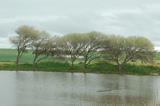


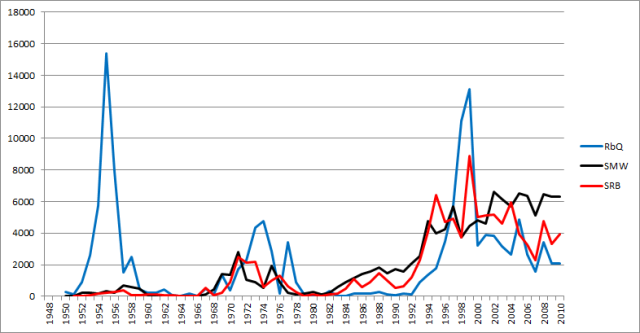
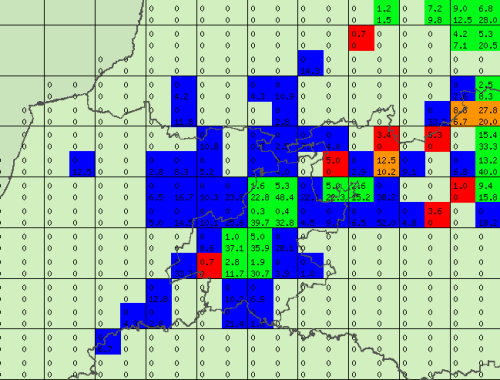 This is part of the range change map between SABAP1 and
This is part of the range change map between SABAP1 and 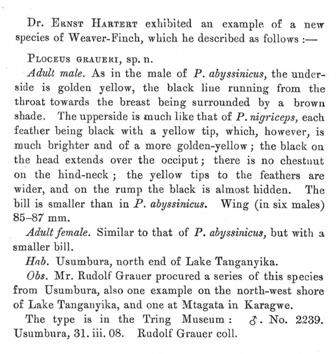
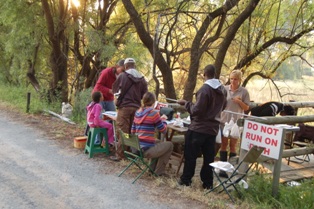
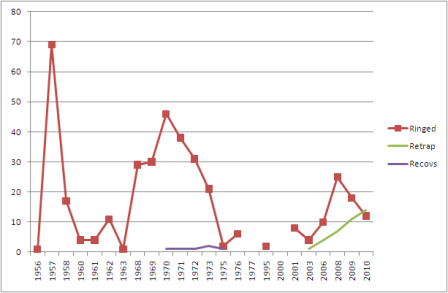 T. Farkas (1966. The birds of Barberspan. Ostrich Suppl. 6:463-491) counted 24 White-browed Sparrow-weaver nests at Barberspan in 1963 – 1964. Peter Turner counted c. 20 nests in a couple of acacias on 25 July 1964 (Nest Record Cards 780.068 and 780.071); two nests contained eggs. There were no further nest counts at Barberspan until March 2010 during a SAFRING ringing workshop.
T. Farkas (1966. The birds of Barberspan. Ostrich Suppl. 6:463-491) counted 24 White-browed Sparrow-weaver nests at Barberspan in 1963 – 1964. Peter Turner counted c. 20 nests in a couple of acacias on 25 July 1964 (Nest Record Cards 780.068 and 780.071); two nests contained eggs. There were no further nest counts at Barberspan until March 2010 during a SAFRING ringing workshop.
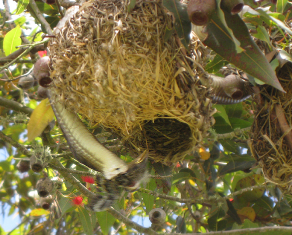 There are some interesting photos and records in
There are some interesting photos and records in 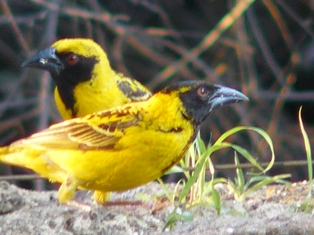 On 14 December 2010 Shaun McCartney photographed a Village Weaver of the northern subspecies at Welgevonden Main Gate (-24.203333,27.900278). Shaun writes: "It was feeding with about a dozen of the local variety. We observed it for the length of 2 x Windhoek lagers and 1x Jamieson- It was late afternoon (between 17h30 and 19h00). I was in the company of Gerhard Lorist, an accomplished Birder, who noticed the difference between the two. The following day (and on subsequent days) Gerhard returned to try and photograph the bird but it was AWOL."
On 14 December 2010 Shaun McCartney photographed a Village Weaver of the northern subspecies at Welgevonden Main Gate (-24.203333,27.900278). Shaun writes: "It was feeding with about a dozen of the local variety. We observed it for the length of 2 x Windhoek lagers and 1x Jamieson- It was late afternoon (between 17h30 and 19h00). I was in the company of Gerhard Lorist, an accomplished Birder, who noticed the difference between the two. The following day (and on subsequent days) Gerhard returned to try and photograph the bird but it was AWOL."
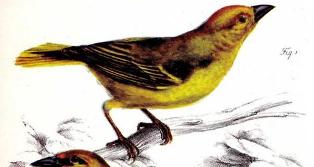
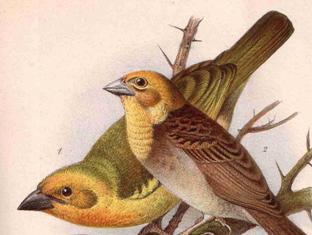
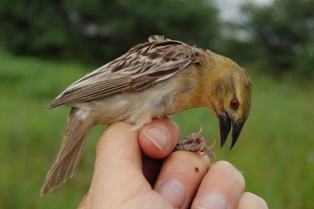 The Chestnut Weaver breeds erratically in Namibia, mostly between December and May. A colony was found 2 weeks ago by Gudrun Middendorff - the colony was some 25 km north of Windhoek, and males and females were seen. On 5 February Gudrun, Neil Thomson and I put nets up to catch the breeding birds. A total of 37 females, all with distinct brood patches, were caught and ringed. No males were present in line with males deserting colonies soon after egg laying or hatching of the chicks. Several low nests were reached by ladder and 4 active nests contained 3 small chicks each. A fifth breeding nest contained 2 white Red-headed Finch eggs. Other low nests were unlined. This colony was submitted to PHOWN (Photos of Weaver Nests) - see
The Chestnut Weaver breeds erratically in Namibia, mostly between December and May. A colony was found 2 weeks ago by Gudrun Middendorff - the colony was some 25 km north of Windhoek, and males and females were seen. On 5 February Gudrun, Neil Thomson and I put nets up to catch the breeding birds. A total of 37 females, all with distinct brood patches, were caught and ringed. No males were present in line with males deserting colonies soon after egg laying or hatching of the chicks. Several low nests were reached by ladder and 4 active nests contained 3 small chicks each. A fifth breeding nest contained 2 white Red-headed Finch eggs. Other low nests were unlined. This colony was submitted to PHOWN (Photos of Weaver Nests) - see 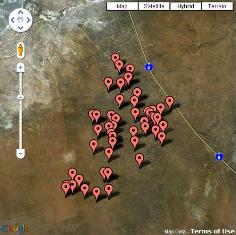
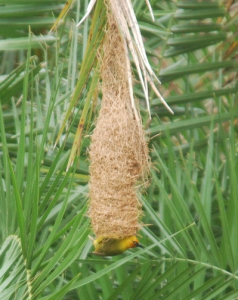 The second newsletter of PHOWN project has been produced. In the six months of running, over 550 records have been submitted to PHOWN. The species with the most records is the Southern Masked Weaver, followed by the Cape Weaver. The featured species in this newsletter is the Spectacled Weaver - it may be possible to obtain estimates of nest lengths from the photos.
The second newsletter of PHOWN project has been produced. In the six months of running, over 550 records have been submitted to PHOWN. The species with the most records is the Southern Masked Weaver, followed by the Cape Weaver. The featured species in this newsletter is the Spectacled Weaver - it may be possible to obtain estimates of nest lengths from the photos.
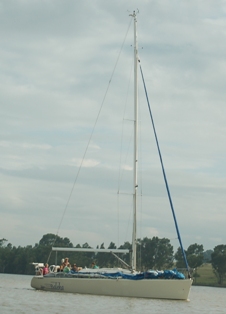 The Vaal Dam CWAC (Coordinated Waterbird Counts) took place on an overcast Sunday morning on 22 january 2011. This annual event is organised by BirdLife Vaal Dam and sponsored by SASOL, and I was asked to fly up for the weekend to help. En route to, and on, the Vaal dam, I was able to record many weaver colonies. Several Southern Masked Weaver colonies were recorded at Kloofzicht where Alan Brooks took me to ring weavers. The Vaal Dam was flooded and many Southern Masked Weaver colonies, and some Southern Red Bishop colonies were found in parts of our waterbird count section. Most, but not all, colonies were recorded. The colonies were all in Eucalyptus trees, many standing in water and others on the shore. Many of these colonies would not be accessible except by boat. Thanks to skipper, Herbert, and the rest of the crew of the yacht "Baleka", Rosemary Giraud for her organising, and SASOL, for this opportunity! The weaver colonies recorded on the weekend may be viewed
The Vaal Dam CWAC (Coordinated Waterbird Counts) took place on an overcast Sunday morning on 22 january 2011. This annual event is organised by BirdLife Vaal Dam and sponsored by SASOL, and I was asked to fly up for the weekend to help. En route to, and on, the Vaal dam, I was able to record many weaver colonies. Several Southern Masked Weaver colonies were recorded at Kloofzicht where Alan Brooks took me to ring weavers. The Vaal Dam was flooded and many Southern Masked Weaver colonies, and some Southern Red Bishop colonies were found in parts of our waterbird count section. Most, but not all, colonies were recorded. The colonies were all in Eucalyptus trees, many standing in water and others on the shore. Many of these colonies would not be accessible except by boat. Thanks to skipper, Herbert, and the rest of the crew of the yacht "Baleka", Rosemary Giraud for her organising, and SASOL, for this opportunity! The weaver colonies recorded on the weekend may be viewed 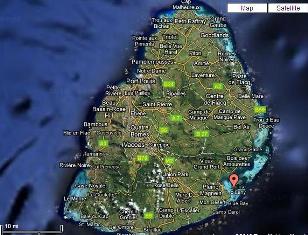
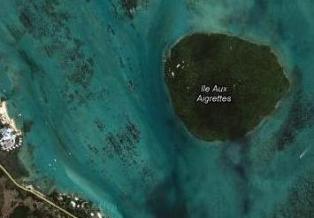
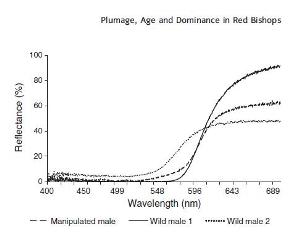 Reflectance spectra of two Southern Red Bishop males found in the wild (solid line shows upper extreme of plumage colouration in the field; dotted line shows an example of the lower end of plumage variation) in comparison to a manipulated male (dashed line) in the aviary. The manipulation was applied with a red Copic marker selected to correspond to the colour variation found in the field.
Reflectance spectra of two Southern Red Bishop males found in the wild (solid line shows upper extreme of plumage colouration in the field; dotted line shows an example of the lower end of plumage variation) in comparison to a manipulated male (dashed line) in the aviary. The manipulation was applied with a red Copic marker selected to correspond to the colour variation found in the field.